

Zitierweise / cite as:
Payer, Alois <1944 - >: Chronik Thailands = กาลานุกรมสยามประเทศไทย. -- Chronik 1992 / B. E. 2535. -- 2. datiert. -- Fassung vom 2017-03-19. -- URL: http://www.payer.de/thailandchronik/chronik1992b.htm
Erstmals publiziert: 2012-10-12
Überarbeitungen: 2017-03-19 [Ergänzungen] ; 2016-12-29 [Ergänzungen] ; 2016-11-07 [Ergänzungen] ; 2016-09-13 [Ergänzungen] ; 2016-07-05 [Ergänzungen] ; 2016-05-02 [Ergänzungen] ; 2016-03-22 [Ergänzungen] ; 2016-02-09 [Ergänzungen] ; 2016-02-01 [Ergänzungen] ; 2015-08-26 [Ergänzungen] ; 2015-07-06 [Ergänzungen] ; 2015-06-07 [Ergänzungen] ; 2015-04-15 [Ergänzungen] ; 2014-10-31 [Ergänzungen] ; 2014-10-24 [Ergänzungen] ; 2014-10-08 [Ergänzungen] ; 2014-08-21 [Ergänzungen] ; 2014-04-10 [Ergänzungen] ; 2013-10-12 [Ergänzungen] ; 2013-10-01 [Ergänzungen] ; 2013-04-26 [Teilung des Jahrgangs] ; 2013-04-16 [Ergänzungen] ; 2013-04-11 [Ergänzungen] ; 2013-04-06 [Ergänzungen] ; 2013-03-28 [Ergänzungen] ; 013-02-14 [Ergänzungen] ; 2013-01-13 [Ergänzungen] ; 2012-11-12 [Ergänzungen]
©opyright: Dieser Text steht der Allgemeinheit zur Verfügung. Eine Verwertung in Publikationen, die über übliche Zitate hinausgeht, bedarf der ausdrücklichen Genehmigung des Herausgebers.
Dieser Text ist Teil der Abteilung
Thailand von
Tüpfli's Global Village Library
ช้างตายทั้งตัวเอาใบบัวปิดไม่มิด
|
Gewidmet meiner lieben Frau Margarete Payer die seit unserem ersten Besuch in Thailand 1974 mit mir die Liebe zu den und die Sorge um die Bewohner Thailands teilt. |
|
Bei thailändischen Statistiken muss man mit allen Fehlerquellen rechnen, die in folgendem Werk beschrieben sind:
Die Statistikdiagramme geben also meistens eher qualitative als korrekte quantitative Beziehungen wieder.
|
1992-01-01 - 1996-12-31
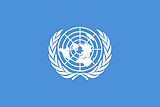
Der Ägypter Boutros Boutros-Ghali (بطرس بطرس غالي) (1922 - ) ist Generalsekretär der UNO.
Abb.: Boutros Boutros-Ghali (بطرس بطرس غالي) mit der SChauspielerin Sophia Loren (links), 1992
[Bildquelle: United Nations Photo. -- http://www.flickr.com/photos/un_photo/3309579801/. -- Zugriff am 2013-05-22. -- Creative Commons Lizenz (Namensnennung, keine kommerzielle Nutzung, keine Bearbeitung)]
1992-01-01
Einführung einer Mehrwertsteuer von 7%. Sie ersetzt die bisherige Business Tax.
1992-01-06
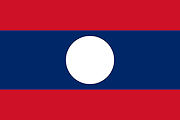
Der Präsident von Laos, Kaysone Phomvihane (ໄກສອນ ພົມວິຫານ, 1920 - 1992) trifft zu einem 10tägigen Staatsbesuch ein.
Abb.: Kaysone Phomvihane (ໄກສອນ ພົມວິຫານ), DDR, 1982
[Bildquelle: Bundesarchiv, Bild 183-1982-0921-039 / CC-BY-SA]
1992-01-15
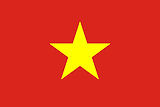
Ministerpräsident Anand trifft in Vietnam zu einem dreitägigen offiziellen Besuch ein. Thailand fordert Vietnam auf, seine Beziehungen zur USA zu normalisieren.
1992-01-16

Tod von Ajahn Chah Subbhado (พระโพธิญาณเถร / หลวงปู่ชา สุภทฺโท, 1918 - 1992)
Abb.: Statue von Ajahn Chah Subhaddo (ชา สุภัทโท), 2008
[Bildquelle: Akuppa John Wigham. -- http://www.flickr.com/photos/90664717@N00/3090908538/. -- Zugriff am 2012-06-05. -- Creative Commons Lizenz (Namensnennung)]
"Venerable Ajahn Chah Subhaddo (Chao Khun Bodhinyana Thera - พระโพธิญาณเถร) (Thai: ชา สุภัทโท, alternatively spelled Achaan Chah, occasionally with honorific titles Luang Por (หลวงพ่อ) and Phra (พระ); 17 June 1918 – 16 January 1992) was an influential teacher of the Buddhadhamma and a founder of two major monasteries in the Thai Forest Tradition. Respected and loved in his own country as a man of great wisdom, he was also instrumental in establishing Theravada Buddhism in the West. Beginning in 1979 with the founding of Cittaviveka (commonly known as Chithurst Buddhist Monastery) [1] in the United Kingdom, the Thai Forest Tradition of Ajahn Chah has spread throughout Europe, the United States and the British Commonwealth. The dhamma talks of Ajahn Chah have been recorded, transcribed and translated into several languages.
More than one million people, including the Thai royal family, attended Ajahn Chah's funeral in 1992.[2] He left behind a legacy of dhamma talks, students, and monasteries.
Early lifeAjahn Chah was born on 17 June 1918 near Ubon Ratchathani (อุบลราชธานี) in the Isaan (อีสาน) region of northeast Thailand. His family were subsistence farmers. As is traditional, Ajahn Chah entered the monastery as a novice at the age of nine, where, during a three-year stay, he learned to read and write. He left the monastery to help his family on the farm, but later returned to monastic life on 16 April 1939, seeking ordination as a Theravadan monk (or bhikku).[3] According to the book Food for the Heart: The Collected Writings of Ajahn Chah, he chose to leave the settled monastic life in 1946 and became a wandering ascetic after the death of his father.[3] He walked across Thailand, taking teachings at various monasteries. Among his teachers at this time was Ajahn Mun (มั่น ภูริทตฺโต / ຫຼວງປູ່ມັ່ນ ພູຣິທັຕໂຕ, 1870 - 1949), a renowned meditation master in the Forest Tradition. Ajahn Chah lived in caves and forests while learning from the meditation monks of the Forest Tradition. A website devoted to Ajahn Chah describes this period of his life:
Thai forest traditionFor the next seven years Ajahn Chah practiced in the style of an ascetic monk in the austere Forest Tradition, spending his time in forests, caves and cremation grounds. He wandered through the countryside in quest of quiet and secluded places for developing meditation. He lived in tiger and cobra infested jungles, using reflections on death to penetrate to the true meaning of life.
During the early part of the twentieth century Theravada Buddhism underwent a revival in Thailand under the leadership of outstanding teachers whose intentions were to raise the standards of Buddhist practise throughout the country. One of these teachers was the Venerable Ajahn Mun Bhuridatta. Ajahn Chah continued Ajahn Mun's high standards of practise when he became a teacher.
The monks of this tradition keep very strictly to the original monastic rule laid down by the Buddha known as the vinaya. The early major schisms in the Buddhist sangha were largely due to disagreements over how strictly the training rules should be applied. Some opted for a degree of flexibility (some would argue liberality) whereas others took a conservative view believing that the rules should be kept just as the Buddha had framed them. The Theravada tradition is the heir to the latter view. An example of the strictness of the discipline might be the rule regarding eating: they uphold the rule to only eat between dawn and noon. In the Thai Forest Tradition monks and nuns go further and observe the 'one eaters practice', whereby they only eat one meal during the morning. This special practice is one of the thirteen dhutanga - optional ascetic practices permitted by the Buddha that are used on an occasional or regular basis to deepen meditation practice and promote contentment with little. They might, for example, as well as eating only one meal a day, sleep outside under a tree, or dwell in secluded forests or graveyards.
Monasteries foundedAfter years of wandering, Ajahn Chah decided to plant roots in an uninhabited grove near his birthplace. In 1954, Wat Nong Pah Pong (วัดหนองป่าพง) monastery was established, where Ajahn Chah could teach his simple, practice-based form of meditation. He attracted a wide variety of disciples, which included in 1966, the first Westerner, Venerable Ajahn Sumedho.[4] Wat Nong Pah Pong [5] includes over 250 branches throughout Thailand, as well as over 15 associated monasteries and ten lay practice centers around the world.[4]
In 1975, Wat Pah Nanachat (International Forest Monastery) was founded with Ajahn Sumedho (อาจารย์สุเมโธ) as the abbot. Wat Pah Nanachat (วัดป่านานาชาติ) was the first monastery in Thailand specifically geared towards training English-speaking Westerners in the monastic Vinaya, as well as the first run by a Westerner.
In 1977, Ajahn Chah and Ajahn Sumedho were invited to visit the United Kingdom by the English Sangha Trust who wanted to form a residential sangha.[6] 1979 saw the founding of Cittaviveka (commonly known as Chithurst Buddhist Monastery due to its location in the town of Chithurst) with Ajahn Sumedho as its head. Several of Ajahn Chah's Western students have since established monasteries throughout the world.
By the early 1980s, Ajahn Chah's health was in decline due to diabetes. He was taken to Bangkok for surgery to relieve paralysis caused by the diabetes, but it was to little effect. Ajahn Chah used his ill health as a teaching point, emphasizing that it was "a living example of the impermanence of all things...(and) reminded people to endeavor to find a true refuge within themselves, since he would not be able to teach for very much longer".[4] Ajahn Chah would remain bedridden and ultimately unable to speak for ten years, until his death on January 16, 1992 at the age of 73.[7]"
[Quelle: http://en.wikipedia.org/wiki/Ajahn_Chah. -- Zugriff am 2012-06-05]
1992-01-16
Feuer zerstört das Viharn (วิหาร, erbaut 1839) des birmanischen Wat Sri Chum in Lampang (ลำปาง).
Abb.: Lage von Lampang (ลำปาง)
[Bildquelle: OpenStreetMap. -- Creative Commons Lizenz (Namensnennung, share alike)]
1992-01-21
In Bangkok werden in vier Hauptstraßen Bus-Spuren eingeführt, in: Phahon Yothin (ถนนพหลโยธิน), Sukhumvit (ถนนสุขุมวิท), Phetkasem (ถนนเพชรเกษม) und Suk Sawat (ถนนสุขสวัสดิ์) Roads.
Abb.: Lage der Phahon Yothin Road (ถนนพหลโยธิน)
[Bildquelle: OpenStreetMap. -- Creative Commons Lizenz (Namensnennung, share alike)]
Abb.: Lage der Sukhumvit Road (ถนนสุขุมวิท)
[Bildquelle: OpenStreetMap. -- Creative Commons Lizenz (Namensnennung, share alike)]
Abb.: Lage der Phetkasem (ถนนเพชรเกษม)
[Bildquelle: OpenStreetMap. -- Creative Commons Lizenz (Namensnennung, share alike)]
Abb.: Lage der Suk Sawat Road (ถนนสุขสวัสดิ์)
[Bildquelle: OpenStreetMap. -- Creative Commons Lizenz (Namensnennung, share alike)]
1992-01-21
Chamlong Srimuang (จำลอง ศรีเมือง, 1935 - ) tritt als Bürgermeister von Bangkok zurück, um an den nationalen Wahlen am 22. März teilnehmen zu können. Chamlong hatte in den sechs Jahren als Bürgermeister der Stadt 80 Mio. Baht erspart, indem er Aufträge öffentlich ausschrieb.
1992-01-27/28
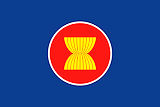
Auf dem Gipfeltreffen der ASEAN in Singapur wird eine Erklärung zur Schaffung einer südostasiatischen Wirtschaftsgemeinschaft verabschiedet.
Abb.: Lage von Singapur
[Bildquelle: OpenStreetMap. -- Creative Commons Lizenz (Namensnennung, share alike)]
1992-02-02
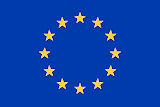
Die Außen- und Finanzminister der zwölf Staaten der Europäischen Gemeinschaft unterzeichnen den Vertrag von Maastricht. Damit ist die Europäische Union (EU) konstituiert.
Abb.: Entwicklung von der EWG (Europäischen Wirtschaftsgemeinschaft) zur EU (Europäischen Union) bis 2007 (animated gif)
[Bildquelle: JLogan / Wikipedia. -- Public domain]
1992-02-19
Wild Animal Reservation and Protection Act of BE 2535. Danach ist die Jagd, die Aufzucht, der Besitz und der Handel von 15 Tierarten strikt verboten:
- Sirintaraschwalbe (Pseudochelidon sirintarae, นกเจ้าฟ้าหญิงสิรินธร)
- Java-Nashorn (Rhinoceros sondaicus, แรดชวา)
- Sumatra-Nashorn (Dicerorhinus sumatrensis, กระซู่)
- Kouprey (Bos sauveli, กูปรี)
- Wilder Wasserbüffel (Bubalus bubalis (B. arnee), ควายป่า)
- Leierhirsch (Cervus eldii, ละองละมั่ง)
- Schomburgk-Hirsch (Cervus schomburgki, สมัน)
- Chinesischer Serau (Capricornis sumatraensis)
- Chinesischer Goral (Naemorhedus griseus, กวางผา)
- Gurney's Pitta (Pitta gurneyi, นกแต้วแร้วท้องดำ)
- Saruskranich (Grus antigone, นกกระเรียนไทย)
- Marmorkatze (Pardofelis marmorata, แมวลายหินอ่อน)
- Schabrackentapir (Tapirus indicus, สมเสร็จไทย)
- Tenasserim-Muntjac (Muntiacus feae, เก้งหม้อ)
- Dugong (Dugong dugon, พะยูน)
Abb.: Sirintaraschwalbe (Pseudochelidon sirintarae, นกเจ้าฟ้าหญิงสิรินธร)
[Bildquelle: L. Shyamal / Wikipedia. -- Creative Commons Lizenz (Namensnennung, share alike)]
1992-02-24
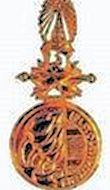
Zu National Artists (ศิลปินแห่งชาติ) werden ernannt:
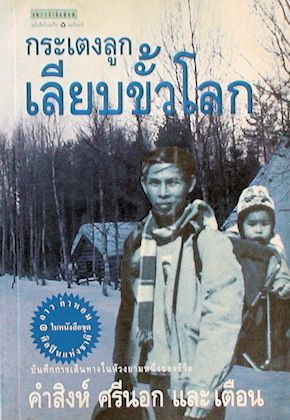
Abb.: Einbanadtitel eines Buchs von Khamsing Srinawk (นายคำสิงห์
ศรีนอก)
[Fair use]
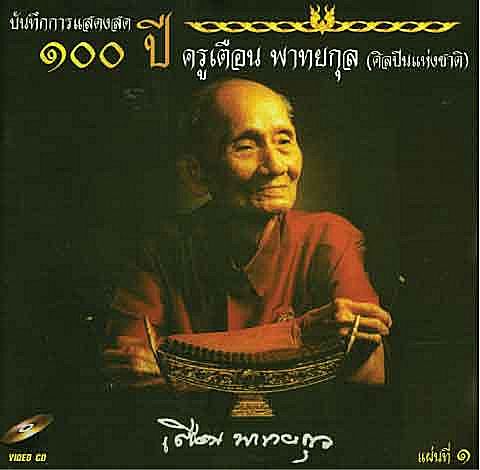
Abb.: VCD zum 100. Geburtstag von Tuen Patayakul (นายเตือน พาทยกุล)
[Fair use]
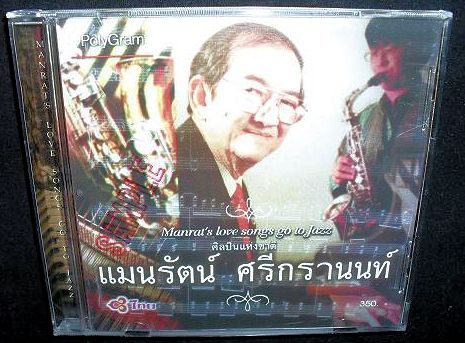
Abb.: CD-Titel von Manratana Srigranont
(ร.อ.ต.แมนรัตน์ ศรีกรานนท์)
[Fair use]
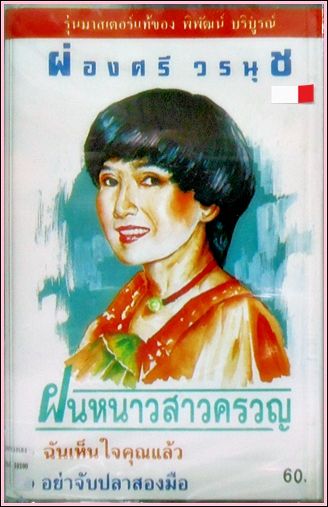
Abb.: Kassettentitel von Pongsri Woranuch (นางผ่องศรี
วรนุช)
[Fair use]
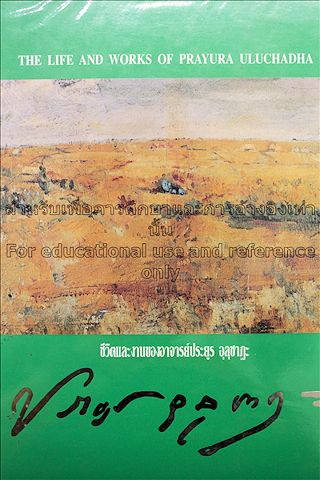
Abb.: Einbandtitel eines Buchs über Prayoon Uluchata (นายประยูร อุลุชาฎะ)
[Fair use for educational use and reference]
1992-02-26
Durch einen Verkehrsunfall stirbt die Luk Thung (ลูกทุ่ง) und Molam (หมอลำ) Sängerin Hani Sri Isan (ฮันนี่ ศรีอีสาน, geb. 1970).
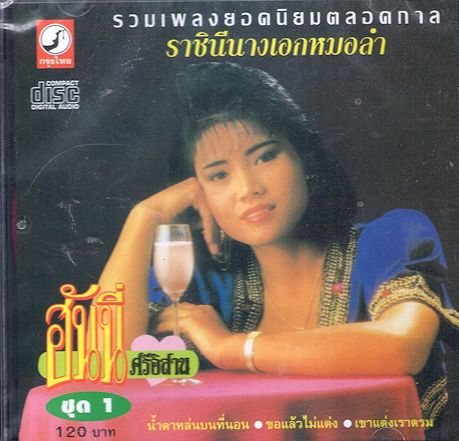
Abb.:
CD-Titel
[Fair use]
1992-02-28
Palace Discotheque in Bangkok schließt. Seit ihrer Eröffnung 1984 war es eine der erfolgreichsten Diskotheken Bangkoks. Sie hatte ein Fassungsvermögen von 5.000 Personen, fasste manchmal aber bis zu 7.000. Die Schließung erfolgte, weil bei Polizeirazzien Jungendliche unter 20 Jahren in der Diskothek aufgegriffen worden waren.
1992-02-28
Das Assets Examinations Committee (คณะกรรมการตรวจสอบการกระทำที่ก่อให้เกิดความเสียหายแก่รัฐ) unter Gen. Sitthi Chirarojana (สิทธิ จิรโรจน์, 1920 - ) schließt seine Arbeit ab. Das Committee hatte die Herkunft unüblicher Vermögenszuwächse bei Mitgliedern der Regierung Chatichai (ชาติชาย ชุณหะวัณ) untersucht.
Abb.: Sitthi Chirarojana (สิทธิ จิรโรจน์)
[Bildquelle: th.Wikipedia. -- Fair Use]In der kurzen Regierungszeit vom 1988-08-04 - 1991-02-23 (ca. 19 Monate) haben die als schuldig befundenen folgenden Regierungsmitglieder folgende Vermögen aufgehäuft, die nun konfisziert werden:
Abb.: Konfisziertes Vermögen, das Mitglieder der Regierung Chatichai (1988-08-04 - 1991-02-23) während ihrer Amtszeit durch Korruption erworben haben
[Datenquelle: Murray (1996), S. 65]
Abb.: Hat den Staat in 18 Monaten um 226 Mio. Baht bestohlen: Chatichai Choonhavan (ชาติชาย ชุณหะวัณ) (rechts, mit US-Präsident George Bush), 1991
[Bildquelle: US-Embassy / Wikipedia. -- Public domain]Freigesprochen wurden folgende Regierungsmitglieder, die in 18 Monaten zum Teil auch einen erstaunlichen Vermögenszuwachs hatten. In Bevölkerung und Presse vermutet man, dass nicht alles mit rechten Dingen zuging.
Abb.: Während 18 Monaten Regierungszeit von Mitgliedern der Regierung Chatichai "rechtmäßig" erworbenes Vermögen (ohne Vermögen bei ausländischen Kreditinstituten!)
[Datenquelle: Murray (1996), S. 61f.]
Abb.: Offenkundig ein Finanzgenie: kann in 18 Monaten in der Regierung "rechtmäßig" 300 Mio. Baht erwerben. Wahlplakat, Bangkok, 2007
[Bildquelle: Timo Kozlowski / Wikipedia. -- GNU FDLicense]
1992-03-03
Die Polizei verteidigt, dass sie bekannte Kriminelle ohne Gerichtsverfahren einfach erschießt. 1991 wurden in Thailand auf diese Weise 80 Kriminelle hingerichtet. Wie gut dieses Verfahren sei, beweist die Polizei so: 1991 hat man 10 Autodiebe erschossen, daraufhin ging Autodiebstahl in Bangkok um 40% zurück. Auf zur munteren Jagd! Hallali!
1992-03-04

Zur Erinnerung an ihren 36. Geburtstag (2. April 1991) eröffnet Prinzessin Sirindhorn (มหาจักรีสิรินธร) in Amphoe Hang Chat (ห้างฉัตร), Provinz Lampang (ลำปาง) das Thai Elephant Conservation Center (ศูนย์อนุรักษ์ช้างไทย).
Abb.: Lage des Thai Elephant Conservation Center (ศูนย์อนุรักษ์ช้างไทย)
[Bildquelle: OpenStreetMap. -- Creative Commons Lizenz (Namensnennung, share alike)]
Abb.: Monument am Thai Elephant Conservation Center (ศูนย์อนุรักษ์ช้างไทย)
[Bildquelle: Love Krittaya / Wikimedia. -- Public domain]
"The National Elephant Institute was founded as the Thai Elephant Conservation Center (TECC). Subsequently in January 2002, in order to enlarge the scope of conservation efforts and address the issues facing Thailand's elephants, it was proposed that the TECC be renamed the National Elephant Institute. It is located in Amphoe Hang Chat, Lampang Province. The main objective for the establishment of the new National Elephant Institute is to develop elephant conservation in a sustainable way and preserve local traditions for future generations. The Institute also aims to improve the tourism business, in which there is an extensive involvement of elephants in tourism-related activities, for the benefit of elephants as well as tourists."
[Quelle: http://en.wikipedia.org/wiki/National_Elephant_Institute. -- Zugriff am 2011-12-15]
1992-03-04

Frankreich: Premiere des Films Diên Biên Phu von Pierre Schoendoerffer (1928 - 2012). Er behandelt den französischen Indochinakrieg und die Niederlage der Franzosen. Der Film wurde ausschließlich in Vietnam gedreht.
Abb.: ©DVD-Titel
[Fair use]
1992-03-10

Der König amnestiert 11 Richter, die im Vorjahr gegen den Justizminister rebelliert hatten und aus dem Justizdienst entlassen worden waren. Sie werden wieder eingestellt, dürfen aber nicht befördert werden.
1992-03-12
Securities and Exchange Act
1992-03-14
Premiere des Films รองต๊ะแล่บแปล๊บ (The Magic Shoes) von Prachya Pinkaew (ปรัชญา ปิ่นแก้ว, 1962 - )
Abb.: Filmplakat
[Bildquelle: th.Wikipedia. -- Fair use]
1992-03-15

NZZ: Thailands Nordosten - ein Armenhaus : Die Parteien auf Stimmenfang
Abb.: Isaan (อีสาน)
[Bildquelle: Hdamm / Wikipedia. -- GNU FDLicense]
"Traditioneller Stimmenkauf Im Isaan (อีสาน) wie auch in den ändern ländlichen Gegenden Thailands ist es üblich, dass die Wähler ihre Stimme verkaufen. Dabei handelt es sich indessen nicht einfach um eine kommerzielle Transaktion zwischen den Dorfbewohnern und irgendeinem dubiosen Stimmenfänger einer beliebigen Partei, und das Ganze hat auch nichts mit Wahlschwindel oder -manipulation zu tun - was allerdings daneben auch noch vorkommt. Als Stimmenwerber treten Personen auf, die in ihrer Gemeinschaft einen gewissen Respekt gemessen, wie Dorfvorsteher, Lehrer, Händler oder Verwaltungsbeamte, Leute auch, die als Anlaufstelle dienen, wenn ein einfacher Bauer in Not gerät. Solche Beziehungsstrukturen finden sich zunächst auf der untersten, dörflichen Ebene und setzen sich bis auf die nationale hinauf fort. Wenn sich ein Wähler für einen Kandidaten entscheidet, ist dies im Grunde zunächst eine Entscheidung für einen bestimmten Stimmenwerber, der ihn aufsucht und der ihm persönlich bekannt ist. Diese Person ist sein direkter Ansprechpartner, wenn es darum geht, bei Krankheitsfällen in der Familie finanzielle Unterstützung zu erhalten, einen Kredit, einen Wasserbüffel oder einen Traktor zu organisieren oder für einen Verwandten eine Arbeitsstelle zu finden. Die Einbettung in ein solches Beziehungsgefüge stellt namentlich für die armen Landbewohner eine Art Lebens- oder Sozialversicherung dar. Dies ist der wichtigste Aspekt des sogenannten Stimmenkaufs, denn die paar wenigen Baht, die der einzelne vor dem Urnengang direkt ausgehändigt bekommt, sind rasch ausgegeben."
[Quelle: NZZ Internationale Ausgabe. -- 1992-03-15. -- S. 6. -- Fair use]
1992-03-22
Bildung des "Committee to Administer and Investigate Elections to the House of Representatives" (คณะกรรมการติดตามและสอดส่องดูแลการเลือกตั้งสมาชิกสภาผู้แทนราษฎร), des Vorläufers der Election Commission of the Kingdom of Thailand (คณะกรรมการการเลือกตั้ง).
"Die Wahlkommission Thailands (Thai: คณะกรรมการการเลือกตั้ง; im englischen: Election Commission of Thailand oder kurz ECT) ist eine von der thailändischen Verfassung vorgeschriebene unabhängige Behörde, die für die korrekte Durchführung von Senats- (วุฒิสภาไทย), Parlaments- (สภาผู้แทนราษฎรไทย), Distrikts- (อำเภอ) und Bezirkswahlen zuständig ist. Die Wahlkommission agierte in der Vergangenheit äußerst aktiv und umstritten. Durch das Erzwingen von Neuwahlen und die Disqualifikation von Kandidaten beeinflusste sie den Ausgang der Senatswahl 2000 und der Parlamentswahlen 2006 und 2007." [Quelle: http://de.wikipedia.org/wiki/Wahlkommission_Thailands. -- zugriff am 2012-10-07]
1992-03-22

Wahlen. Als jüngster Abgeordneter aller Zeiten wird der 28jährige Abhisit Vejjajiva (อภิสิทธิ์ เวชชาชีวะ, geb. 1964) als ein Abgeordneter Bangkoks gewählt.
Abb.: Sitzverteilung nach der Wahl März 1992
"General elections were held in Thailand on 22 March 1992, the first after the National Peace Keeping Council overthrew the elected government of Chatichai Choonhavan in a coup on 23 February 1991. A total of 15 parties and 2,185 candidates contested the 360 seats. The result was a victory for the Samakkee Dhamma, which won 79 seats, despite receiving fewer votes than the New Aspiration Party. Voter turnout was 59.2%.[1] Results
Party Votes % Seats +/- New Aspiration Party (พรรคความหวังใหม่) 9,980,150 22.4 72 New Samakkee Dhamma (พรรคสามัคคีธรรม) 8,578,529 19.3 79 New Thai Nation Party (พรรคชาติไทย) 7,305,674 16.4 74 -13 Phalang Dharma Party (พรรคพลังธรรม) 5,104,849 11.5 41 +35 Democrat Party (พรรคประชาธิปัตย์) 4,705,376 10.6 44 -4 Social Action Party (พรรคกิจสังคม) 3,586,714 8.1 31 -23 Thai Citizen Party 2,280,887 5.1 7 -24 Solidarity Party 1,315,075 3.0 6 New Mass Party 443,568 1.0 1 -4 People Party 376,580 0.8 4 -17 United New Force 337,361 0.8 0 New Thai People Party 158,037 0.4 1 -16 Local Progress Party 158,808 0.4 0 New Free Agriculture Party 152,692 0.3 0 New United Democracy Party 34,651 0.1 0 New Invalid/blank votes 547,726 - - - Total 19,216,466 100 360 +3 Source: Nohlen et al [Quelle: http://en.wikipedia.org/wiki/Thai_general_election,_March_1992. -- Zugriff am 2011-11-04]
1992-03-27

Der Vorsitzende der Samakkhi Tham Party (พรรคสามัคคีธรรม), Narong Wongwan (นายณรงค์ วงศ์วรรณ, 1925 - ), verliert seine Chance, Ministerpräsident zu werden, nachdem das US State Departement bestätigt, dass ihm im Juli 1991 das Einreisevisum verweigert wurde, da er im Verdacht steht, in Drogenhandel verwickelt zu sein. Narong bestreitet natürlich die Vorwürfe.
Narong Wongwan und seine Familie sind Inhaber bzw. Teilhaber von u.a.
Thepawong (เทพวงศ์)
Siam Tobacco Export Corporation (ไซแอมโทแบคโค
เอกซ์ปอร์ตคอร์ปอเรชั่น) Thai Tobacco Industrial
General Tobacco Co. Ltd.
Chiang Rai Borikan
Abb.: Lage der Provinz Phrae (แพร่)
[Bildquelle: CIA. -- Public domain]
"Narong Wongwan (Thai: ณรงค์ วงศ์วรรณ; born 25 December 1925) is a former Thai politician and tobacco industrialist. He was a long-term member of parliament representing Phrae (แพร่), leader of the United Thai Party and the Justice Unity Party (พรรคสามัคคีธรรม). He was publicly known as the "godfather" (เจ้าพ่อ) (jao pho) of Phrae[1][2] or even "godfather of the North".[3][4] Life and career
Narong Wongwan was born in Phrae, where his grandfather had acquired a fortune from wood production. Narong studied economics in the United States. After working for the family's saw mill for some time, he went into tobacco growing and curing in the 1950s. During the 1970s the tobacco business in Northern Thailand boomed and Narong became a multi-millionaire. Many peasants of Phrae and the neighbouring provinces were employed on Narong's and his family's plantations and in their curing plants. Therefore, he accumulated considerable economic and social influence in the region. This was used by him as a base for his political career.
Narong was a member of Phrae's provincial council as early as 1949. He founded the United Thai Party and was elected member of parliament in 1979. He was steadily re-elected in all elections until 1992. He joined the government of prime minister Prem Tinsulanonda (1920 - ), becoming deputy interior minister in 1980, deputy minister of agriculture in 1981, rising to be minister in 1983. After the election of 1986, his party was in the opposition. In 1989, he merged his party with three minor parties and renamed it Solidarity Party. After a cabinet reshuffle, the party became part of Chatichai Choonhavan's (ชาติชาย ชุณหะวัณ, 1920 - 1998) government coalition and Narong was again made minister of agriculture.[1]
After the coup d'état of 1991 and ahead of the election in March 1992, he joined with other provincial businessmen, bureaucrats and supporters of the military coup group to form the Justice Unity Party (พรรคสามัคคีธรรม), of which he became the chairman. The party won the election and Narong was designated prime minister, when media alleged that the United States had refused him entry admission due to the suspection of involvement in drug trafficking. The US government threatened that relations between the two countries could worsen in case that Narong became head of government.[5] He had to relinquish premiership and the parliament instead nominated the putschist General Suchinda Kraprayoon (สุจินดา คราประยูร, 1933 - ).[6] Really, Narong had not been prosecuted as there was no sufficient evidence. As the leader of the biggest coalition party, Narong still became deputy prime minister under Suchinda. After the bloody crackdown on the oppositional movent protesting against the military-backed government, the Justice Unity Party was discredited and dissolved.[7] Narong instead joined the Thai Nation Party (พรรคชาติไทย). After the party's electoral success in 1995, Narong was poised to become minister of interior, but again he was hindered by allegations of criminal activity.[4] In 2000, Thailand's Supreme Court condemned the tabloid newspaper Khao Sot (ข่าวสด) for spreading false allegations against Narong.[8]"
[Quelle: http://en.wikipedia.org/wiki/Narong_Wongwan. -- Zugriff am 2014-11-22]
1992-03-29

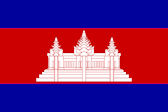
Truppen Malaysias nehmen an der Grenze zwischen Thailand und Kambodscha Aufstellung, um die von der UNO organisierte Rücksiedelung kambodschanischer Flüchtlinge aus Thailand nach Kambodscha zu überwachen. Die Truppen sind für die Sicherheit der Flüchtlinge zuständig bis diese zivilen Organsationen übergeben sind, die sie in den Rücksiedlungs-Gebieten betreuen.
1992-04-03

Der VII. Nationale Volkskongress (全国人民代表大会) Chinas bestätigt den ökonomischen Reformkurs Chinas.
1992-04-07 - 1992-05-06
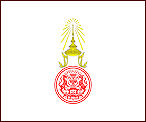
General Suchinda Kraprayoon (สุจินดา คราประยูร, 1933 - ) ist Ministerpräsident (นายกรัฐมนตรีแห่งราชอาณาจักรไทย - Prime Minister). Suchinda wird von einer Allianz von fünf Pro-Militär-Parteien getragen.
"Suchinda Kraprayoon (Thai: สุจินดา คราประยูร; * 6. August 1933 in der Provinz Nakhon Pathom) war im Jahr 1992 Premierminister von Thailand. Suchinda ist der Sohn von Juang und Sompong Kraprayoon. Er heiratete später Khunying Wannee Kraprayoon (Nuhnpakdi).
Suchinda wurde zunächst an der Wat Radschabopit-Schule und an der Amnuayslip-Schule ausgebildet. Anschließend ging er an die Medizinschule der Chulalongkorn-Universität in Bangkok. Nach einem Jahr trat er in die Kadettenakademie der thailändischen Armee ein und ging dann an die arrivierte Chula Chom Klao Armee-Akademie, die nach dem Curriculum der US-Militärakademie in West Point lehrte. Auch besuchte er den Army Command and General Staff Course beim Artillerieregiment in Fort Skills, Oklahoma (USA) sowie in Fort Leavenworth.
Nach seiner Rückkehr 1953 diente er als Unterleutnant bei der thailändischen Armee. Am 25. Januar 1958 wurde er Gruppenführer in einem Artillerie-Infanterie-Regiment. Seine Karriere ging dann über eine Lehrtätigkeit an der Armeeschule, über das Generaldirektorat der Operationsabteilung zum Kommandeur der thailändischen Armee und schließlich am 29. April 1990 zum Oberkommandierenden. Als Nachfolger von General Sundara Kongsompongsa wurde er am 1. Oktober 1991 zugleich Chef des Obersten Hauptquartiers.
Suchinda war beteiligt an den blutigen Maßnahmen, die am 23. Februar 1991 zur Entmachtung des amtierenden Premierministers Chatichai Choonhavan führten, der anschließend das Land zunächst verlassen musste. Nach den allgemeinen Wahlen am 22. März 1992 waren fünf Parteien für die Ernennung Suchindas zum Premierminister. Am 7. April wurde er deshalb ernannt, doch sah er sich umgehend großen Protesten ausgesetzt. Diese gipfelten in einer allgemeinen Ausgangssperre und Militäreinsatz in Bangkok. Eine endgültige Eskalation konnte durch das Eingreifen von König Bhumibol vermieden werden. Die von zahlreichen politischen Richtungen unterstützten Proteste führten am 24. Mai zum Rücktritt von Suchinda. Der stellvertretende Premierminister, Meechai Ruchuphan, übernahm das Amt für die Übergangsperiode, bis die neue Regierung eingesetzt war. Nachfolger wurde erneut Anand Panyarachun."
[Quelle: http://de.wikipedia.org/wiki/Suchinda_Kraprayoon. -- Zugriff am 2011-10-06]
1992-04-07 - 1992-05-24
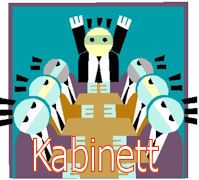
48. Kabinett: Suchinda (สุจินดา)
1992-04-07 - 1992-07-31
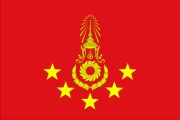
General Isarapong Noonpakdee (พลเอก อิสระพงศ์ หนุนภักดี, 1933 - ) ist Commander-in-Chief of the Royal Thai Army (ผู้บัญชาการทหารบก).
Abb.: Isarapong Noonpakdee (พลเอก อิสระพงศ์ หนุนภักดี)
[Bildquelle: th.Wikipedia. -- Fair use]
1992-04-16
Erste Parlamentssitzung: alle Abgeordneten der Opposition erscheinen in Trauerkleidung als Protest gegen die Wahl von Gen Suchinda zum Ministerpräsidenten.
1992--04-19

Bei einer Wahlbeteiligung von nur 23% wird Kritsada Arunwong na Ayutthaya (กฤษฎา อรุณวงษ์ ณ อยุธยา, 1932 – 2010), Kandidat der Phalang Dharma Party (พรรคพลังธรรม), zum Bürgermeister von Bangkok (ผู้ว่าราชการกรุงเทพมหานคร) gewählt.
Abb.: Kritsada Arunwong na Ayutthaya (กฤษฎา อรุณวงษ์ ณ อยุธยา)
[Bildquelle: th.Wikipedia. -- Fair use]
"Kritsada Arunwong na Ayutthaya (Thai: กฤษฎา อรุณวงษ์ ณ อยุธยา) (January 9, 1932 – January 12, 2010) was a Thai politician and architect. He served as the Governor of Bangkok from April 19, 1992 until April 18, 1996. Biography Education
Krisada received both his bachelor's degree and his master's degree in architecture from Massachusetts Institute of Technology (M.I.T).[1] The government of France awarded him a scholarship to study architecture for six months at the Ecole des Beaux-Arts in 1960.
CareerHe employed in the Royal Thai Army's (กองทัพบกไทย) Public Works Department from 1957 to 1960. He held the Military rank of Captain (ร้อยเอก).
From 1960 until 1989, Kritsada was a professor and lecturer of architecture at Chulalongkorn University (จุฬาลงกรณ์มหาวิทยาลัย), During his tenure at Chulalongkorn, he also served as the fourth dean of the Faculty of Architecture for four years from 1974 until 1978.
Kritsada founded the Casa Company, which designed several prominent buildings throughout Bangkok, including the headquarters on Thai Airways International (การบินไทย) on Phahon Yothin Road (ถนนพหลโยธิน).
He served as the deputy Governor of Bangkok for public works from 1990 until 1992. Kritsada was then elected as the Governor of Bangkok for four years from April 19, 1992 until April 18, 1996.
Later lifeKritsada was honored as a National Artist of Thailand (ศิลปินแห่งชาติ) for his work in visual arts and architecture in 2007.
Kritsada Arunwong na Ayutthaya died of coronary artery disease on January 12, 2010, at Siriraj Hospital (โรงพยาบาลศิริราช) at the age of 78. His funeral was held at Wat Benchamabophit (วัดเบญจมบพิตรดุสิตวนารามราชวรวิหาร)."
[Quelle: http://en.wikipedia.org/wiki/Kritsada_Arunwong_na_Ayutthaya. -- Zugriff am 2011-12-15]
1992-04-23
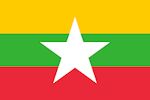
General Than Shwe (သန်းရွှေ, 1933 - ) wird Staats- und Regierungschef Myanmars.
Abb.: Than Shwe (သန်းရွှေ) / von Murray Webb (1947 - ), 2008Caricature of General Than Shwe of Myanmar. In the forefront of the cartoon are bags of 'fortified wheat flour' from the World Food Programme' and piles of bags of other kinds of food staples as well that have been sent to Myanmar by aid organisations. Behind the sacks of food is a heavy chain which stretches across the area preventing the food from being taken into Myanmar. There is also a signpost showing crossed swords below a grinning skull which is headed with the name 'Myanmar'. General Shwe stands in front of the signpost and chain with his arms outstretched indicating that he is the instigator of this refusal to accept international aid to help the victims of Cyclone Nargis which struck Myanmar on May 3 2008.
[Quelle von Bild und Text: General Than Shwe, Myanmar. 15 May, 2008. Webb, Murray, 1947- :[Digital caricatures published from 29 July 2005 onwards (2006, 2007, 2008). Includes a selection of digital caricatures published from 2002 and up to July 2005.]. Ref: DCDL-0006511. Alexander Turnbull Library, Wellington, New Zealand. http://natlib.govt.nz/records/22803577. -- Zugriff am 2013-03-07. -- "You can copy this item for personal use, share it, and post it on a blog or website. It cannot be used commercially without permission"]
Abb.: General Than Shwe (သန်းရွှေ) (rechts) mit Ministerpräsident Abhisit Vejjajiva (อภิสิทธิ์ เวชชาชีวะ), 2010
[Bildquelle: Photographer attached to the Prime Minister of the Kingdom of Thailand : Peerapat Wimolrungkarat / พีรพัฒน์ วิมลรังครัตน์. -- http://www.flickr.com/photos/thaigov/5072256379/in/set-72157625142907784/. -- Zugriff am 2012-01-27. -- Creative Commons Lizenz (Namensnennung)]
1992-05
Somkhuan Harikul (พลตำรวจโท สมควร หริกุล, 1924 - ) macht eine Intervention, dass der Regierung verboten wird, die Village Scouts (ลูกเสือชาวบ้าน) zu mobilisieren.
1992-05-04
Über 60.000 demonstrieren auf dem Sanam Luang gegen General Suchindas Ernennung zum Ministerpräsidenten. Maj Gen Chamlong Srimuang (พลตรี จำลอง ศรีเมือง), der Vorsitzende der Phalang Dharma Party (พรรคพลังธรรม), tritt in Hungerstreik "bis zum Tod", um Suchinda zum Rücktritt zu zwingen. 60% der Demonstranten sind über 30 Jahre alt, 70% haben einen Hochschulabschluss.
Die Protestierenden werden durch ihre Spottnamen charakterisiert:
Handy-Mob
Picknick-Mob
Yogurth-Trinker-Mob
Yuppie-Mob
1992-05-05 - 1992-05-21
Demonstrationen außerhalb Bangkoks gegen Suchinda
Abb.: Teilnehmer an von der Regierung organisierten Pro-Suchinda-Demonstrationen außerhalb Bangkoks, 1992-05-15 (in Tausend)
[Datenquelle: LoGerfo, James P. -- In: Money & power in provincial Thailand / edited by Ruth McVey. -- Copenhagen : NIAS, 2000. -- 288 S. ; 23 cm. -- ISBN 87-87062-70-4. -- S. 235]
Abb.: Prozent der Provinzen, in denen es Protestdemonstrationen gegen Suchinda gibt
[Datenquelle: LoGerfo, James P. -- In: Money & power in provincial Thailand / edited by Ruth McVey. -- Copenhagen : NIAS, 2000. -- 288 S. ; 23 cm. -- ISBN 87-87062-70-4. -- S. 239]
1992-05-08
Miss Universe Schönheitswahl in Bangkok. Siegerin wird Michelle McLean aus Namibia.
1992-05-11
Abb.: Sanitsuda Ekachai (สนิทสุดา เอกชัย)
[Bildquelle: FAO]Bangkok Post: Sanitsuda Ekachai (สนิทสุดา เอกชัย, 1955 - ): "The hospital's official sorcerer"
Im Spital von Amphoe Mae Chaem (อำเภอแม่แจ่ม), Provinz Chiang Mai (เชียงใหม่), ist ein Medzinmann (Zauberdoktor) angestellt. Der 29jährige Anand Kulmeng lernte als Novize und Mönch im Kloster 16 Jahre lang Heilkräuterkunde und Magie. Jetzt ist er Laie.
"I personally think the rites are just a psychological trick to strengthen their will. Without this, it would not work."
Der Medizinmann selber hat Sorgen, gegen die Magie nichts hilft: er ist verschuldet, u.a. wegen seines neuen Motorrads.
"It's strange too. The spirits seem to loose their power as development comes to our villages. It won't be long before we are no longer needed."
Abb.: Lage von Amphoe Mae Chaem (อำเภอแม่แจ่ม)
[Bildquelle: OpenStreetMap. -- Creative Commons Lizenz (Namensnennung, share alike)]
Abb.: Amphoe Mae Chaem (อำเภอแม่แจ่ม), 2010
[Bildquelle: David Callahan. -- http://www.flickr.com/photos/callahancorner/4837412010/. -- Zugriff am 2012-05-07. -- Creative Commons Lizenz (Namensnennung, keine kommerzielle Nutzung, share alike)]
1992-05-14
Bangkok Post: Sanitsuda Ekachai (สนิทสุดา เอกชัย, 1955 - ): "Spiritual police work"
Über die Impersonation des höchsten Dorfgeists Phra Chao Luang (พระเจ้าหลวง) durch das weibliche Medium Mae Kongkaew Kannikaa (60) in Mae Chaem (อำเภอแม่แจ่ม), Provinz Chiang Mai (เชียงใหม่) (Lage siehe oben). Manchmal kommt Phra Chao Luang nicht persönlich in die mediale Sitzung, sondern schickt seine Untergebenen.
Das Medium wird im Ritual zum Dorfgeist. Sie schreit und sauft. Alles, was sie berührt wird heilig. Sie wird befragt nach den Ursachen für Krankheiten und Unglück. Auf die Frage nach den Ursachen schwerer Magenschmerzen antwortet der Dorfgeist:
"He's bad. He forsakes traditions. He did not care of his ancestral spirits. He is lazy. Instead of making merit for the spirits of grandfathers and grandmothers in the morning, he waited until the evening. And the food. It was not even specially prepared. He bought it from the market."
Das Gezeter von Phra Chao Luang (พระเจ้าหลวง) scheint nicht besonders wirksam zu sein: Das Dorf ist hochverschuldet. Viele müssen ihr ererbtes Land verkaufen. Drogensucht ist wachsend, schon 10 Personen sind HIV-positiv.
1992-05-15
Die Regierung organisiert in vielen Provinzen außerhalb Bangkoks Pro-Suchinda-Demonstrationen:
Abb.: Anzahl der Demonstrationen gegen Suchinda außerhalb Bangkoks, 1992-05-05 - 1992-05-21
[Datenquelle: LoGerfo, James P. -- In: Money & power in provincial Thailand / edited by Ruth McVey. -- Copenhagen : NIAS, 2000. -- 288 S. ; 23 cm. -- ISBN 87-87062-70-4. -- S. 237]
1992-05-17
Die Regierung befiehlt der Polizei, auf friedvolle Demonstranten zu schießen. Es gibt zahlreiche Tote und Verwundete. In Bangkok bricht ein Bürgerkrieg zwischen Protestierenden und "Ordnungs"kräften aus, der bis zum 20. dauert. Chamlong wird verhaftet. Dutzende werden von den "Ordnungs"kräften ermordet, über 300 verwundet.
Abb.: Lage des Sanam Luang (สนามหลวง)
[Bildquelle: OpenStreetMap. -- Creative Commons Lizenz (Namensnennung, share alike)]
"Black May (Thai: พฤษภาทมิฬ phruetsapha thamin) is a common name for the 17–20 May 1992 popular protest in Bangkok against the government of General Suchinda Kraprayoon (สุจินดา คราประยูร) and the bloody military crackdown that followed. Up to 200,000 people demonstrated in central Bangkok at the height of the protests. The military crackdown resulted in 52 officially confirmed deaths, many disappearances, hundreds of injuries, and over 3,500 arrests. Many of those arrested allegedly were tortured. Background
On February 23, 1991, Army Commander Suchinda Kraprayoon overthrew the government of Chatichai Choonhavan (ชาติชาย ชุณหะวัณ). The coup-makers, who called themselves the National Peace-Keeping Council (NPKC,คณะรักษาความสงบเรียบร้อยแห่งชาติ), appointed Anand Panyarachun (อานันท์ ปันยารชุน) as Prime Minister (นายกรัฐมนตรีแห่งราชอาณาจักรไทย). Anand's interim government promulgated a new constitution and scheduled parliamentary elections for March 22, 1992.
A government coalition with 55% of the lower house was formed and appointed General Suchinda as Prime Minister. Massive public protests immediately followed. On May 9, Suchinda responded by saying he would support a constitutional amendment making individuals who had not been elected to Parliament ineligible for the premiership. Tensions dissipated; however, the truce was short-lived.
Popular protestsOn May 17, 1992 the two leading government parties announced that, while they supported the constitutional amendment, they also favoured transitional clauses that would permit Suchinda to serve as prime minister for the term of the Parliament. As it became clear the government parties would not honour their word, plans went ahead for a strike on Sunday 17 May.
May 17Obviously concerned about the people's mounting anger, the Interior Minister ordered provincial governors to prevent people from travelling to Bangkok to join the rally. Suchinda threatened to sack the Governor of Bangkok for allegedly assisting the anti-government rallies of the previous week, while the army hastily arranged a competing "Anti-Drought Musical Festival" to be held at the Army Auditorium. Radio stations were banned from playing recordings by several popular singers who had voiced their support for the demonstrations.
Nevertheless, the rally was the biggest since the downfall of the Thanom regime in October 1973. At its peak, 200,000 people filled Sanam Luang (สนามหลวง), overflowing on to the encircling streets. At about 8:30pm, Chamlong Srimuang (จำลอง ศรีเมือง) and Dr. Sant Hatthirat led the protesters on a 2-kilometre march to Government House, to demand Suchinda's resignation. As they reached the intersection of Rachadamnoen and Rachadamnoen Nok Avenues, they were halted at Phan Fa Bridge, which had been barricaded with razor wire by the police. At 11:00pm a group of demonstrators attempted to break through the barricade, but were repulsed by water cannon from four fire trucks blocking the way. The protesters then tried to commandeer one of the fire trucks, but were beaten back by riot police armed with batons. Protestors replied with stones and Molotov cocktails. Chamlong used a loudspeaker to urge the marchers not to attack the police, but his words were ignored. In this initial clash, about 100 protesters and 21 policemen were injured.
May 18By midnight two fire engines had been set on fire, and the situation was spiralling out of control. Some 700 troops had been called in and the fighting fanned out from Phan Fa Bridge. At 0:30am Suchinda declared a state of emergency, making gatherings of more than ten people illegal. The government urged people to go home, as hospitals in the area were already receiving the injured, including four with gunshot wounds who died that night.[2] Chamlong remained near Phan Fa Bridge and the nearby Democracy Monument. About 4:00am, soldiers threatened the nearly 40,000 protesters by firing M16 rifles into the air. An hour and a half later, they began firing again. By the morning, the army brought in more troops, and crowds grew larger at other sections of the city.
Early on the afternoon of 18 May, Suchinda publicly accused Chamlong of fomenting violence and defended the government’s use of force. Shortly afterward, troops firing continuously in the air moved in to surround Chamlong. He was handcuffed and arrested.
However, the crowds did not disperse, and the violence escalated. After government troops secured the area around Phan Fa Bridge and the Democracy Monument, protests shifted to Ramkhamhaeng University in the east of the city. By evening of 19 May, some fifty thousand people had gathered there.
Royal interventionEarly on the morning of 20 May, the very popular Princess Sirindhorn (มหาจักรีสิรินธร) addressed the country on television, calling for a stop to the violence. Her appeal was rebroadcast throughout the day. That evening, her brother, Crown Prince Vajiralongkorn (สมเด็จพระบรมโอรสาธิราช เจ้าฟ้ามหาวชิราลงกรณฯ สยามมกุฎราชกุมาร), broadcast a similar appeal. Finally, at 9:30 pm, a television broadcast of King Bhumibol Adulyadej, Suchinda, and Chamlong was shown, in which the King demanded that the two men put an end to their confrontation and work together through parliamentary procedures. Suchinda released Chamlong and announced an amnesty for protesters. He also agreed to support an amendment requiring the prime minister to be elected. Chamlong asked the demonstrators to disperse, which they did. On 24 May 1992, Suchinda resigned as Prime Minister of Thailand.
Press censorshipThe front page of the International Herald Tribune's 20 May 1992 issue was blacked out with felt tip pen, as was an editorial of the Bangkok Post of the same date, though other articles relating to the demonstrations remained untouched. The English-language newspaper The Nation and two Thai-language newspapers were shut down on May 21 though the order was rescinded a few hours later.[8]
AftermathThe violence resulted in 52 officially acknowledged deaths, hundreds of injuries, and many disappearances. Over 3,500 people were arrested; hundreds of them were women and children. Many arrested claimed to have been tortured; some were beaten, left to sit in sweltering sunlight, soaked in gasoline and threatened with immolation, and left to go hungry.
A House of Representatives Special Committee and a Fact-Finding Committee led by Sophon Rattanakorn shared the same conclusion: the government of General Suchinda used excessive force to crack down on the rally. Some facts from the investigation, such as names of military officers and military units responsible for rounding up, killing, and torturing of protesters were revealed to the public. It is believed these facts were recorded on the report of the Defense Ministry's Fact Finding Committee led by General Pichit Kullawanit, and is still kept from the Thai public.
The military constitution of 1992 remained in place until 1997, when a replacement was drafted and promulgated.
Chamlong later apologized for his role in the events: "I wanted a peaceful rally," he said. "I can’t deny some responsibility for the damage and loss of life. I feel deeply sorry for those families whose members were killed in the incident, for those people who were injured and their families." Nevertheless, he noted that "we were right in what we have done." He then retired from politics.
Suchinda was later appointed Chairman of Telecom Asia (today known as True), a company which received a concession to install 2 million telephone lines in Bangkok during the Anand government. Anand became Chairman of Saha-Union Group, which had received an Independent Power Producer concession during his government.
References[Quelle: http://en.wikipedia.org/wiki/Black_May_%281992%29 . -- Zugriff am 2011-12-15]
- David Murray. Angels and Devils. White Orchid Press (1996).
- Murray
- Bangkok Post, May 17, 1992
- The Nation, May 16, 1992
- David van Praagh. Thailand's Struggle for Democracy. Holmes & Meier (1996).
- Duncan McCargo. Chamlong Srimuang and the New Thai Politics. Hurst & Co. (1997).
- McCargo
- Mansell, Robin (2007). The Oxford handbook of information and communication technologies. Oxford University Press. p. 548. ISBN 978-0199266234."
Der amerikanische Journalist William Greider (geb. 1936) analysiert die "bürgerliche Revolution" völlig zutreffend:
"Professor Lae Dilokvidhyarat [แล ดิลกวิทยรัตน์] , Wirtschaftswissenschaftler an der Chulalongkorn-Universität [จุฬาลงกรณ์มหาวิทยาลัย], beschrieb, welche Spannungen es zwischen den verschiedenen Bevölkerungsschichten gab: »Die Mittelklasse hat inzwischen einen größeren politischen Einfluss und fühlt sich nicht mehr vom Militär oder von den Bürokraten bedroht, aber sie sorgt auch dafür, dass sie und damit die Wirtschaft von der Politik der niedrigen Löhne und der Ausbeutung der Bauern profitiert. Sie reagiert erheblich stärker auf die internationale Gemeinschaft, daher handelt sie auch subtiler als bei der Unterdrückung durch die Militärs. Die Mittelklasse weiß, dass man eine Kuh erst füttern muss, bevor man sie melken kann, während das Militärregime die Kuh für ein dummes Tier gehalten und mit einem Stock verprügelt hat.« Anders ausgedrückt: Die oberflächliche Annahme, dass Kapitalismus zwangsläufig zu einer bürgerlichen Demokratie führe, war angesichts der komplexen gesellschaftlichen Realität in einem Staat wie Thailand völlig irrelevant. Wenn sich die herrschende Klasse, die sich auf die Militärs und die Mitglieder der königlichen Familie stützte, einfach zu einer neuen Aristokratie entwickelte, die sich auf den Reichtum stützt, kann es noch Jahrhunderte dauern, bis es in Thailand eine moderne Demokratie gibt. Ob letzten Endes überhaupt eine echte Demokratie entstehen kann, hängt von den vielen Unwägbarkeiten der thailändischen Geschichte und Kultur ab, aber ganz besonders von der Frage, welche sozialen Klassen sich bilden. Die Mittelklasse wird mit der Zeit vielleicht so stark sein, dass sie ihre Interessen vertreten kann, aber entwickeln sich auch die wirtschaftlichen Grundlagen, die notwendig sind, um größere Reformen durchzusetzen, welche auch die Interessen der Bauern und Arbeiter berücksichtigen? Oder sieht die Mittelklasse die Anstrengungen dieser Menschen als Gefahr für ihren eigenen Kampf?"
[Quelle: Greider, William <1936 - >: Endstation Globalisierung : neue Wege in eine Welt ohne Grenzen. -- München : Heyne, 1999. -- (Heyne Business ; 22/1056). -- ISBN 3-453-15552-1. -- Originaltitel: One world, ready or not (1997). -- S. 631f.]
Das brutale Vorgehen der Regierung führt zu einem Massenexodus von Touristen:
"After the military began the killing on 17 May, tourists around the country packed their bags, and hotels and travel agencies received a flood of cancellations. The scenes of military brutality broadcast on television screens around the world had a strong and immediate impact on the tourist industry. (Catalyst for Change, pp. 78-79; and interview with Sittisak Thapngam, chief administrator of the Association of Thai Travel Agents, May 1994). The Songkhla [สงขลา] Chamber of Commerce commissioned a survey shortly after the crisis ended, which found that the Hat Yai [หาดใหญ่] tourist business was down by 40 per cent in May. In Hat Yai, the sudden loss of tourist income brought hotel owners, tour operators, and even nightclub singers out on the streets to demonstrate against Gen. Suchinda and the use of violence (interview with Chan Leelaphon, president, Songkhla Chamber of Commerce on 6 May 1994; and Phichai Sisai, president of the Southern Campaign for Popular Democracy on 5 May 1994)." [Quelle: LoGerfo, James P. -- In: Money & power in provincial Thailand / edited by Ruth McVey. -- Copenhagen : NIAS, 2000. -- 288 S. ; 23 cm. -- ISBN 87-87062-70-4. -- S. 265, Anm. 56. -- Fair use]
Abb.: Lage von Hat Yai [หาดใหญ่]
[Bildquelle: OpenStreetMap. -- Creative Commons Lizenz (Namensnennung, share alike)]
1992-05-18
Bangkok Post: Sanitsuda Ekachai (สนิทสุดา เอกชัย, 1955 - ): "Leader longing for change"
Der Damm-Meister Phor Pan Kulmeng in Amphoe Mae Chaem (อำเภอแม่แจ่ม, Lage siehe oben), Provinz Chiang Mai (เชียงใหม่), muss die Männer dazu bewegen, einen neuen Damm zu bauen. Teenager hatten bei einem Grillfest den 54jährigen Holzdamm in Flammen gesetzt. Da jetzt die Bauern das ganze Jahr herum tätig sind, um Landwirtschaftsprodukte für den Verkauf anzubauen, haben sie kaum Zeit für Fronarbeit. Auch wird es wegen der rasanten Entwaldung immer schwieriger, Bäume für die ständig nötige Reparatur des Damms zu finden. Jede der häufigen Reparaturen erfordert ca. 500 Bäume. Darum hofft der Damm-Meister auf einen Damm aus Beton.
1992-05-18
Bangkok Post: Sanitsuda Ekachai (สนิทสุดา เอกชัย, 1955 - ): "Weaving in and out of debt"
In Amphoe Mae Chaem (อำเภอแม่แจ่ม, Lage siehe oben), Provinz Chiang Mai (เชียงใหม่), verschulden sich die männlichen Bauern immer mehr. Sie spekulieren mit Feldfrüchten (z.B. rote Zwiebeln), die großen Gewinn bringen können, aber auch großen Verlust, da die Investitionskosten in Saatgut, Düngemittel und Pestizide groß sind. Dazu müssen sie Kredite aufnehmen mit monatlichen (!) Zinsen von 5%. Die Frauen sind vorsichtiger und versuchen ihre Männer davon abzubringen, verlorenem Geld gutes Geld nachzuwerfen und weiter mit Feldfrüchten zu spekulieren. Doch erfolglos. Die Frauen trauten sich nicht, mit jemandem außerhalb der Familie darüber zu sprechen, bis ein Thai Entwicklungshelfer-Ehepaar eine Weberinnengruppe gründete. Dort weben Frauen traditionelle Tücher zum Verkauf und tauschen sich über ihre Sorgen mit den Ehemännern aus, die oft der Trunksucht verfallen. Der Tagesverdienst der Weberinnen ist 30 Baht.
Im Dorf Ban Pa Daet (บ้านป่าแดด, 200 Familien) sind die Jahreseinnahmen pro Familie 11.000 Baht, die Gesamtverschuldung der Bauern aus Verlusten mit den Feldfrüchten sind 1,2 Millionen Baht (6000 Baht pro Familie).
"In this day and age, I feel it's the women who provide for the men, not the other way round. When you talk about work in the fields, women do equal work. But when we get home, we still have to cook and clean. And we still work to earn extra income."
"Debt is like a house catching fire. No matter how much I weave, I can't make enough money to get enough water to put out the fire. It's just too late."
Abb.: Lage von Ban Pa Daet (บ้านป่าแดด)
[Bildquelle: OpenStreetMap. -- Creative Commons Lizenz (Namensnennung, share alike)]
Abb.: Typisches Gewebe für Amphoe Mae Chaem (อำเภอแม่แจ่ม): Pa Teen Jok (ผ้าตีนจก), 2008
[Bildquelle: Nina. -- http://www.flickr.com/photos/msnina/2753379364/. -- Zugriff am 2012-05-07. -- Creative Commons Lizenz (Namensnennung, keine kommerzielle Nutzung, share alike)]
1992-05-19
Titelseite der Bangkok Post:
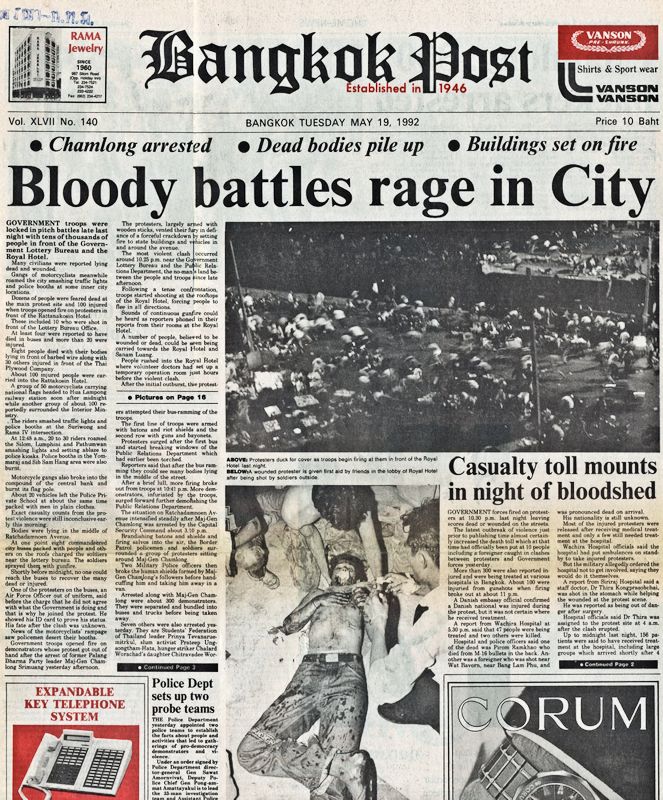
Abb.: Titelseite
der Bangkok Post 1992-05-19
1992-05-20 18:00

Prinzessin Sirindhorn (มหาจักรีสิรินธร, 1955 - ) ruft von Paris aus im Fernsehen dazu auf, das Morden zu beenden.
1992-05-20

Der Kronprinz (พลเอก พลเรือเอก พลอากาศเอก สมเด็จพระบรมโอรสาธิราช เจ้าฟ้ามหาวชิราลงกรณ บดินทรเทพวรางกูร สิริกิติยสมบูรณสวางควัฒน์ วรขัตติยราชสันตติวงศ์ มหิดลพงศอดุลยเดช จักรีนเรศยุพราชวิสุทธ สยามมกุฎราชกุมาร, 1952 - ) ruft von Seoul (Südkorea) aus zur Beendigung des Bürgerkriegs auf.
1992-05-20

Der König beordnet Maj Gen Chamlong Srimuang (พลตรี จำลอง ศรีเมือง) und Ministerpräsiden General Suchinda Kraprayoon (สุจินดา คราประยูร) zu sich und befiehlt ihnen die Auseinandersetzungen zu beenden und einen Kompromiss zu finden (dabei verhält sich seine Majestät so, als ob beide die gleiche Schuld träfe!). Das Video davon wird kurz nach Mitternacht im Fernsehen gezeigt. Ministerpräsident wird Meechai Ruchuphan. Verhaftete Demonstranten werden frei gelassen.
Abb.: Maj Gen Chamlong Srimuang (พลตรี จำลอง ศรีเมือง) und Ministerpräsiden General Suchinda Kraprayoon (สุจินดา คราประยูร) vor dem König, 1992-05-20
[Bildquelle: Wikipedia. -- Fair use]
1992-05-23

Die Washington Post ist begeistert:
"Who will soon forget the remarkable picture of the military ruler and the opposition leader together on their knees before the king of Thailand? Summoning up the impartiality and sense of national essence that he has cultivated for 42 years on an otherwise powerless throne, King Bhumibol Adulyadej was able at least to ease the immediate confrontation between Suchinda Kraprayoon [สุจินดา คราประยูร], the general who is prime minister, and Chamlong Srimuang [จำลอง ศรีเมือง], the former general who leads the opposition. At once Thailand’s boiling crisis was moved from the streets to the political bargaining table."
1992-05-22 - 1992-06-10

49. Kabinett: Meechai (มีชัย)
1992-05-24 - 1992-06-10

Meechai Ruchuphan (มีชัย ฤชุพันธุ์, 1938 - ) ist Ministerpräsident (นายกรัฐมนตรีแห่งราชอาณาจักรไทย - Prime Minister)
"Meechai Ruchuphan (Thai: มีชัย ฤชุพันธุ์, gesprochen [miː-ʧai rí-ʧú-pʰan]; * 2. Februar 1938) ist ein thailändischer Politiker und Rechtsexperte. Nach dem Rücktritt von Premierminister General Suchinda Kraprayoon am 24. Mai 1992 übernahm er bis zum 10. Juni desselben Jahres die Amtsgeschäfte des Premierministers. Unter General Suchinda war Meechai stellvertretender Premierminister. Am 10. Juni wurde Anand Panyarachun zum Premierminister ernannt. Meechai war lange Zeit Sprecher des thailändischen Senats.
Zur Zeit (2007) ist Meechai Ruchuphan Vorsitzender der National Legislative Assembly, einem 242 Mitglieder umfassenden Parlament, das von der Militärregierung eingesetzt wurde. Seine Wahl zum Vorsitzenden war nicht unumstritten. Er galt dem Militär zu nahestehend.[1]
Einzelnachweise
- ↑ Somphan believed that Meechai was the only choice of the CNS because he had been involved in drafting its statements, orders and the interim charter.[1]"
[Quelle: http://de.wikipedia.org/wiki/Meechai_Ruchuphan. -- Zugriff am 2011-10-06]
Bald danach werden die ehemalig (1973 - 1976) kommunistischen Netzwerke wie z.B. der Chula Friends Club (ชมรมเพื่อนจุฬาฯ) reaktiviert, sind jetzt aber bourgeoise.
1992-05-27
Tod von Kraisri Nimmanhaeminda (ไกรศรี นิมมานเหมินท์, 1912 - 1992)
Abb.: Programm der Feier zum 100. Geburtstag von Kraisri Nimmanhaeminda (ไกรศรี นิมมานเหมินท์)
[Bildquelle: http://www.nimman13.com/100years-kraisri-nimmanhaemin/. -- Zugriff am 2016-05-02. -- Fair use]
"It was this month in 1992 that we wrote of the recent passing of Ajarn Kraisri Nimmanahaeminda, ‘Custodian of the old Chiang Mai, midwife to the new’. His family name was actually Nim Han Min, but was changed into Nimmanahaeminda, of the iconic road today (currently spelt Nimmanhaemin). His family owned Warorot Market [ตลาดวโรรส], but after a post graduate degree from Harvard University, he took an academic career path which included leading the Siam Society expedition to discover the Mrabri ‘Spirits of the Yellow Leaves’ tribe, penning numerous cultural studies and academic books about the north of Thailand, played a role in establishing Chiang Mai University, invented kantoke dinners [ขันโตก] (inspired by a luau during a trip to Hawaii), revitalised laquerware and numerous northern crafts, developed the Rincome Hotel (Amari) and succeeding in almost single-handedly revitalising much of Lanna culture. " [Quelle: http://www.chiangmaicitylife.com/citylife-archive/quick-glance-through-past-issues/. -- Zugriff am 2016-05-02. -- Fair use]
1992-06-01

Titelgeschichte des US-Nachrichtenmagazins TIME: Thailand's cry for democracy.
"Bangkok ... was no longer a capital of prosperity. It was a city in shock — numbed by tumult, appalled at wholesale death in the streets and raging at a Prime Minister who had become the most hated man in Thailand. Throughout those three days, people looked imploringly to Chitralada Palace and the one figure capable of intervening decisively. Their long wait had begun to convince many Thais that King Bhumibol ... could not risk squandering his moral authority when words might not matter. Soldiers were at war with civilians. Both sides were digging in. A nation that had been basking in the sunlight of economic success looked headed for eclipse in further nights of the generals. " [Zitiert in: Marshall, Andrew MacGregor <1971 - >: A Kingdom in crisis : Thailand's struggle for democracy in the twenty-first century. -- 2. ed.. -- London : Zed, 2015. -- 240 S. ; 22 cm. -- ISBN 978-1-78360-602-3. -- S. 98. -- Fair use]
1992-06-10 - 1992-09-23

Anand Panyarachun (นาย อานันท์ ปันยารชุน, 1932 - ) ist Ministerpräsident (นายกรัฐมนตรีแห่งราชอาณาจักรไทย - Prime Minister). Der König hatte Somboon Rahong (พลอากาศเอกสมบุญ ระหงษ์, (1932 - 2013) für dieses Amt abgelehnt.
1992-06-10 - 1992-09-23

50. Kabinett: Anand (อานันท์) II
1992-06-13
Tod von Pumpuang Duangjan (พุ่มพวง ดวงจันทร์, geb. 1961), der "Königin des Luk thung (ลูกทุ่ง)". Ihre Kremation wird vom König gesponsert. Hunderttausende nehmen teil.
Künstlerlink auf Spotify:
URI: spotify:artist:7bssbqY8HKop2WbQs7meR6
URL: spotify:artist:7bssbqY8HKop2WbQs7meR6
Abb.: Pumpuang Duangjan (พุ่มพวง ดวงจันทร์)
[Bildquelle: th.Wikipedia. -- Fair use]
Abb.: Lage von Suphan Buri (สุพรรณบุรี)
[Bildquelle: OpenStreetMap. -- Creative Commons Lizenz (Namensnennung, share alike)]
"Pumpuang 'Peung' Duangjan (Thai พุ่มพวง ดวงจันทร์) (Birth name Rampheung Chithan - รำพึง จิตรหาญ, 1961 - 1992), or 'Poompuang Moon' as she was referred to in Thailand, was the professional name of a Thai megastar singer, actress who pioneered electronic Luk Thung (ลูกทุ่ง). She is considered one of the most important Luk Thung vocalists in Thailand. The child of poor farmers, she came to attention as a teenager in the late '70s. Although she was illiterate, her lyrics were powerful and compelling stories of Thailand's rural poor. She adapted pleng luk thung (Thai country music) into a dance-ready form known as electronic luk thung. Her death in 1992, at the age of 31, led many to believe that her music form would die out. However, it has continued and in 1997 the first all luk thung radio station was opened. Biography Life and Success
Before Pumpuang, 'Luk Thung' (Thai Country Music) was very tame. However, Pumpuang's songwriter, composer and producer - 'Kru Lop Burirat' (ครูลพ บุรีรัตน์). An accomplished musician who played both Western and Thai music, Lop Burirat mixed them both together for a new style. In 1985 they produced the album 'Aue Hue Lor Jang' ( (อื้อฮือหล่อจัง, Oh, he's so cute!), which became a phenomenal success.
'Peung' and Kru Lop quickly released a succession of record-breaking albums including 'Hang Noi Thoi Nid' (ห่างหน่อยถอยนิด), 'Noo Mai Roo' (หนูไม่รู้) and 'Noo Mai Ao' (หนูไม่เอา). While there is no doubt that Look Thung owes Kru Lop a great much, it was 'Peung' who was in charge of her own self-promotion. She performed on stage in a variety of flesh revealing costumes giving her an outrageously sexy look which often brought a severe backlash from music critics and the older generation. Loved, but also loathed, she was criticized for trying to 'copy' Western popstar Madonna and lambasted for her Un-Thai sense of dress and flirtation.
Being undisturbed and completely ignoring her detractors, 'Peung' continued performing in the way she saw fit. Her audiences just loved it. Thailand had never seen anyone like it before! Pumpuang face graced the bigscreen as well, as she starred in various Thai films in career. On September 12, 1989 Pummpuang was given an award by HRH Princess Maha Chakri Sirindhorn (มหาจักรีสิรินธร). HRH Sirindhorn awarded her in the field of outstanding singing for the song "Land of Smiles" composed by teacher 'Rat Buri' in the second half century pastoral sector.
In recent times, a new generation of Look Thung artists such as Yui Yartyuth, Arphaphorn Nakhorn Sawan and Dau Mayuree all pointed to 'Peung' as their inspiration. Til this day she will always be remembered as 'the girl who put the spice into Luk Thung'. [2]
A Life Of Tears and SorrowPumpuang's journey is a 'rags to riches story' of an illiterate peasant girl who achieved legendary status as the 'Queen of Look Thung' is of almost mythical proportion. Though born in Kamphaeng Phet (กำแพงเพชร), central Thailand, she was brought up in Suphanburi province (สุพรรณบุรี) just north of Bangkok. As her family was so poor, 'Peung' was forced to drop out of school after just one year to help her parents in their sugar-cane fields.
Being unable to read did not deter Peung from picking up a microphone and learning by heart a collection of almost 100 songs by the age of twelve. Growing up and wanting to hit the big time, 'Peung' entered the notorious world of 'Cafe and Temple Fair' concerts as a dancer and singer. It was 'on this circuit' where she met her first husband.
The marriage was a rocky one and her husband later ran off with another girl. Adding injury to insult, he returned after the affair and eloped with Peung's younger sister - they married later. The man who married first Peung before her younger sister, was known to the public as an 'alcoholic womanizer' who did nothing but 'live off women'. Family feuds erupted and Peung's brother was sentenced to 15 years in prison after he had killed Peung's former husband in a fit of anger. Another of her brothers, brokenhearted at the rejection of a singer he wished to married, picked up a shotgun one day - placed it at his head and pulled the trigger.
Shortly after shooting to fame, Peung married again and had a baby son. More family quarrels erupted after Peung's mother blamed her new husband for taking advantage of Peung's illiteracy and having her unknowingly, sign over to him - her financial documents and earnings. The marriage did not last long and the couple separated over his supposed womanizing and extortionate spending (of her money)
Over time, Peung's health just went from bad to worse and she was hospitalized several times. In 1992, though still sick, Peung travelled to Chiang Mai (เชียงใหม่) to see her son. Before returning to Bangkok - Peung, close family and friends stopped off to pay their respects at one of Thailand's most revered Buddha Images located at Wat Phra Si Rattana Mahathat (วัดพระศรีรัตนมหาธาตุ) in Phitsanulok province (พิษณุโลก). "She had wanted to pray for her son's well-being" Before even leaving the temple gates - Peung collapsed.
Just as quickly as she had arrived on the stage, she was lost to us. Peung died of kidney failure at Phra Phutthachinnarat hospital in Phitsanulok. She was just 31 years of age.
LegacyPumpuang's importance for Thai music and life is unmatched. She is the 'American Dream' in a Thai version, the girl who, with nothing other than her talent, came from Suphanburi in the Central rice fields (5th child of a 12 children family) to become by far Thailand's most famous and loved singer. She could convincingly sound like a young schoolgirl in love as well as a mature woman looking back on her life. Her voice and songs remain outstanding and the frequency with which her songs are still played, two decades after her death, suggest that she will be remembered far beyond any foreseeable future.
Her success in her musical career was not matched in her private life and public opinion has been tough on her two husbands.
Official records say that she died from Lupus, a non-contagious auto-immune disease. Hundreds of thousands of people came to her funeral, arguably more than for anyone else in recent Thai history. Her funeral was held at Wat Tapkradan in Suphanburi province, an estimated 200,000 people turned up to pay their last respects. Even the Thai king himself, Bhumibol Adulyadej came to pay his respects; for a peasant-born woman this was unheard of and has not been repeated.
Over the years several Thai artists have done their own covers of her songs. In 2005 Mai Charoenpura (ใหม่ เจริญปุระ), popular Thai singer and actress dedicated her 4th album to Pumpuang. She recorded a cover of the luk thung classic "Nak Rong Baan Nok," (นักร้องบ้านนอก) the video is a tribute to Pumpuang's early rise to fame. A statue was also been created in her honor and memory in Suphanburi, Thailand. Fans and Tourists can still be seen today making homage to site.
Discography AlbumsFilmography Movies
- 1983 - Grasshopper Tie a Bow (ตั๊กแตนผูกโบว์)
- 1985 - Aue Hue Lor Jang (อื้อฮือหล่อจัง)
- 1986 - Hang Noi Thoi Nid (ห่างหน่อยถอยนิด)
- Marigold Stars Sprinkle (ดาวเรืองดาวโรย)
- Ashamed of Neon Light (อายแสงนีออน)
- Countryside Singer (นักร้องบ้านนอก)
- Expensive Lesson (บทเรียนราคาแพง)
- Widowed Groom (หม้ายขันหมาก)
- Green Papaya Salad (Som-tum) (ส้มตำ)
- Upcountry Love Song (เพลงรักบ้านทุ่ง)
[Quelle: http://en.wikipedia.org/wiki/Pumpuang_Duangjan. -- Zugriff am 2011-12-09]
- 1984 - Nun (ชี)
- 1984 - Ms. Fresh Coconut Milk (นางสาวกะทิสด)
- 1984 - We're Sorry Love (ขอโทษที ที่รัก)
- 1984 - King Cobra Emerged (จงอางผงาด)
- 1985 - Love Hoow She Is (ที่รัก เธออยู่ไหน)
- 1986 - New Gunman (มือปืนคนใหม่)
- 1987 - Charming Singer (เสน่ห์นักร้อง)
- 1987 - Captive Love (เชลยรัก)
- 1987 - Music Love Song Gun (เพลงรัก เพลงปืน)
- 1988 - Diamond Kingdom (เพชรพยัคฆราช)"
1992-07-25 - 1997-08-09
Olympische Sommerspiele in Barcelona (Spanien). Thailand sendet 51 Athleten und gibt für den Spaß 20 Mio. Baht aus. Einzige Medaille: Bronze für Arkhom Chenglai (อาคม เฉ่งไล่, 1970 - ), Boxen im Weltergewicht.
Abb.: Lage von Barcelona
[Bildquelle: OpenStreetMap. -- Creative Commons Lizenz (Namensnennung, share alike)]
Abb.: Arkhom Chenglai (อาคม เฉ่งไล่)
[Bildquelle: th.Wikipedia. -- Public domain]
1992-08-01
Ministerpräsident Anand enthebt drei hohe Militärs ihres Amts, die für den "Schwarzen Mai" (siehe oben) verantwortlich sind, u.a. den Commander-in-Chief of the Royal Thai Army (ผู้บัญชาการทหารบก).
1992-08-01 - 1995-09-30

General Vimol Vongvanich (พลเอก วิมล วงศ์วานิช, 1934 - ) ist Commander-in-Chief of the Royal Thai Army (ผู้บัญชาการทหารบก).
Abb.: Vimol Vongvanich (พลเอก วิมล วงศ์วานิช)
[Bildquelle: th.Wikipedia. -- Fair use]
1992-08-12

60. Geburtstag von Königin Sirikit. Die Königin ruft alle Thais auf, die Wälder und die Umwelt zu schützen. An der Geburtstagsfeier nehmen ca. 8.000 geladene Gäste teil. Von der Regierung bekommt die Königin eine Diamanten-besetzte Goldkrone.
Zum 60. Geburtstag der Königin errichtet die Luftwaffe auf dem Berg Doi Inthanon (ดอยอินทนนท์) das Naphaphonphumisiri Chedi (นภพลภูมิสิริ).
Abb.: Lage des Doi Inthanon (ดอยอินทนนท์)
[Bildquelle: OpenStreetMap. -- Creative Commons Lizenz (Namensnennung, share alike)]
Abb.: Naphaphonphumisiri Chedi (นภพลภูมิสิริ), Doi Inthanon (ดอยอินทนนท์), 2002
[Bildquelle: Paul Lenz / Wikipedia. -- GNU FDLicense]In Ban Krut (บ้านกรูด), Provinz Prachuap Khiri Khan (ประจวบคีรีขันธ์), wird zum Geburtstag der Königin die 14 m hohe Buddhastatue Phra Buddha Kitti Sirichai (พระพุทธกิติสิริชัย) eingeweiht.
Abb.: Lage von Ban Krut (บ้านกรูด)
[Bildquelle: OpenStreetMap. -- Creative Commons Lizenz (Namensnennung, share alike)]
Abb.: Phra Buddha Kitti Sirichai (พระพุทธกิติสิริชัย), Ban Krut (บ้านกรูด), 2007
[Bildquelle: Anne G. -- http://www.flickr.com/photos/dolescum/965074071/. -- Zugriff am 2012-05-02. -- Creative Commons Lizenz (Namensnennung, keine kommerzielle Nutzung, share alike)]Zum 60. Geburtstag der Königin wird in Bangkok der Benchasiri Park (สวนเบญจสิริ) eröffnet
Abb.: Lage des Benchasiri Parks (สวนเบญจสิริ)
[Bildquelle: OpenStreetMap. -- Creative Commons Lizenz (Namensnennung, share alike)]
Abb.: Benchasiri Park (สวนเบญจสิริ), 2009
[Bildquelel: Ian Fuller. -- https://www.flickr.com/photos/ianfuller/3891629253/. -- Zugriff am 2016-02-01. -- Creative Commons Lizenz (Namensnennung, keine kommerzielle Nutzung)]
1992-08-14

Tod von Acharn Sim Buddhajaro (พระญาณสิทธาจารย์ - สิม พุทฺธาจาโร, geb. 1909), Gründer von von Wat Tham Pha Plong (วัดถ้ำผาปล่อง), Amphoe Chiang Dao (เชียงดาว), Provinz Chiang Mai (เชียงใหม่).
Abb.: Der König im Gespräch mit Acharn Sim Buddhajaro (พระญาณสิทธาจารย์ - สิม พุทฺธาจาโร)
Abb.: Acharn Sim Buddhajaro (พระญาณสิทธาจารย์ - สิม พุทฺธาจาโร)
Abb.: Lage von Amphoe Chiang Dao (เชียงดาว)
[Bildquelle: OpenStreetMap. -- Creative Commons Lizenz (Namensnennung, share alike)]
1992-08-16

Abdul Hadi Awang ( حاج عبدالهادي اوڠ, geb. 1947), stellvertretender Chef der Parti Islam Se-Malaysia (PAS) bietet den muslimischen Aufständischen Unterstützung und Asyl an.
Abb.: Abdul Hadi Awang ( حاج عبدالهادي اوڠ)
2008
[Bildquelle: 사용자:Murdfreak / Wikimedia. -- Creative Commons Lizenz (Namensnennung, share alike)]
"Tuan Guru Dato' Seri Haji Abdul Hadi Awang (Jawi: حاج عبدالهادي اوڠ, born 20 October 1947) is a Malaysian politician who has been President of the Pan-Malaysian Islamic Party [Parti Islam Se-Malaysia], an Islamist political party in Malaysia, since 2002. He was Menteri Besar of Terengganu from 1999 to 2004, and he is the current state assemblyman for Rhu Rendang and Member of Parliament for Marang, both in Terengganu. At the international level, he has been appointed as the Vice President of the International Union of Muslim Scholars. Hadi received his education in the neighbourhood schools before continuing his studies at the Islamic University of Madinah (الجامعة الإسلامية بالمدينة المنورة) between 1969 to 1973, and later at Al-Azhar University جامعة الأزهر (الشريف)). Upon his return to Malaysia he joined ABIM (Angkatan Belia Islam Malaysia / Muslim Youth Movement of Malaysia) in 1977, where he quickly became the Selangor state chief for ABIM. A year later, Hadi joined PAS, under which he contested a parliamentary seat in the 1978 general election. He quickly rose through the ranks. He became PAS Deputy President in 1989, when Fadzil Noor (1937 – 2002) was elected to the party presidency. He remained Deputy President until 2002, when Fadzil died of a heart attack and Hadi succeeded him as PAS President.
He has been featured in the latest publication of “The Muslim 500: The World’s 500 Most Influential Muslims” under category of "Preachers and Spiritual Guides" for 2016 edition. He was said had written several books related to democracy and politics in Islam and also gives lectures every Friday morning at Rusila Mosque which draw thousands of people."
[Quelle: https://en.wikipedia.org/wiki/Abdul_Hadi_Awang. -- Zugriff am 2016-03-17]
1992-08-17
Abb.: Sanitsuda Ekachai (สนิทสุดา เอกชัย)
[Bildquelle: FAO]Bangkok Post: Sanitsuda Ekachai (สนิทสุดา เอกชัย, 1955 - ): "Silenced no longer"
Abb.: Bamrung Boonpanya (บํารุง บุญปญญา)
[Bildquelle: http://www.thaingo.org/writer/view.php?id=460. -- Zugriff am 2012-05-08. -- Fair use]Über Bamrung Boonpanya (บํารุง บุญปญ
ญา) (48). Er ist der Sohn eines Bauern aus Surin ( สุรินทร์), studierte an der Kasetsart University (มหาวิทยาลัยเกษตรศาสตร์) Geologie mit Auszeichnung, arbeitete kurze Zeit als Beamter in einer Landreform-Organisation, trat der ersten thailändischen ländlichen NGO (Non-governmental Organization) bei, lehnte es ab, in den Dienst ausländischer NGOs zu treten, da diese auf die Thais herabschauen, und endete als arbeitsloser Hausmann in Khon Kaen (ขอนแก่น). Als solcher wurde er eine der Hauptfiguren in den Massenprotesten gegen das vom Militär initiierte Khor Chor Kor Umsiedlungsschema. Nach diesem Plan sollten mit 10 Milliarden Baht 500.000 Bauern-Familien in Nordostthailand umgesiedelt werden, um der Wiederbegrünung durch kommerzielle Baumplantagen zu weichen. Die Massenproteste der Bauern, die ihren Höhepunkt in Pak Chong (ปากช่อง), Provinz Nakhon Ratchasima (นครราชสีมา), hatten, führten dazu, dass der Plan gestoppt wurde. Man versucht, Bamrung zu ermorden und er muss nun inkognito leben.Bamrung denkt im Gegensatz zu vielen NGOs, dass die Bauern nicht belehrt werden müssen, sondern, dass man auf sie hören muss.
"The basic underlying proble, "is that of the power relationship between the rich and poor," which if not preempted would place the poor at the receiving end of the negotiating table."
Deswegen bestimmte er bei den Verhandlungen mit der Regierung Verhandlungsort, Verhandlungsführung und Agenda. Dies ganz im Gegensatz zur Thai Unterwürfigkeit.
"We cannot achieve things, if we have to be forever krengchai (เกรงใจ, ehrfürchtig)."
"I was brought up to be deferent, to be compromising. But then I thought of what could happen to Isaan if I were weak. I was afraid too. But then I stood up."
Die verschienenartige Reaktion auf den Schwarzen Mai (พฤษภาทมิฬ) des Mittelstands in Thailand (siehe oben) und die Massenproteste der Bauern in Nordostthailand ist für Bamrung typisch für Thailand:
"Because they don't understand, they say no to the uprising of the poor but yes to the middle class. They kept saying the poor are ignorant, and the only way to solve this is by educating them. The won't support the villagers' fight to have a say. Yet they believe the villagers can be taught by attending seminars to learn the importance of democarcy. For me, it's ridiculous, and sad."
"To regain self-confidence, to shake off the sense of inferiority, we must go back to our identity. This cultural, ideological aspect is not at the fringe of grassroots democracy and enviromental activism. It's at its very core."
Abb.: Lage von Surin (สุรินทร์), Khon Kaen (ขอนแก่น) und Pak Chong (ปากช่อง)
[Bildquelle: OpenStreetMap. -- Creative Commons Lizenz (Namensnennung, share alike)]
1992-08-17
Der Orthopädie-Chirurg Therdchai Jivacete (เทอดชัย ชีวะเกตุ, 1941 - ) gründet die Prostheses Foundation (มูลนิธิขาเทียม ในสมเด็จพระศรีนครินทราบรมราชชนนี), die Prothesen für Unbemittelte kostenlos ausgibt.
"Therdchai Jivacate (เทอดชัย ชีวะเกตุ, born 1941) is a Thai orthopedic surgeon and inventor known for his humanitarian activities in providing free prosthetic limbs to impoverished amputees, and for his development of techniques allowing low-cost, high-quality prostheses to be made from local materials. The activities of the Prostheses Foundation (มูลนิธิขาเทียม ในสมเด็จพระศรีนครินทราบรมราชชนนี), which he founded in 1992 under royal sponsorship from the Princess Mother Srinagarindra (ศรีนครินทรา, 1900 - 1995), have expanded beyond the borders of Thailand to Malaysia, Laos, and Burma. Jivacate has established Thailand's first and only educational institution of occupational therapy at Chiang Mai University (มหาวิทยาลัยเชียงใหม่).[1] He has also created an educational programme for children suffering from chronic diseases at Maharaj Hospital (โรงพยาบาลมหาราช) in Nakhon Ratchasima (นครราชสีมา).[2] In 2008, he was given the Ramon Magsaysay Award for Public Service. In addition to his work with humans, Dr Jivacate has also designed prosthetic limbs for elephants who have been injured by landmines.[3]
Early lifeTherdchai Jivacate graduated from the Faculty of Medicine of Chulalongkorn University (จุฬาลงกรณ์มหาวิทยาลัย) in 1965. From 1968 to 1972 he was a resident of physical medicine and rehabilitation in Northwestern University, while from 1972 to 1975 he specialized in orthopedic surgery at Chiang Mai University (มหาวิทยาลัยเชียงใหม่).[4] One of his first technological discoveries involved manufacturing artificial legs from recycled plastic yogurt bottles. Jivacate used his own funds to simplify and adapt the process and the devices to meet local needs—for instance, designing artificial legs specifically for use by farmers working in wet fields.[5]
Prostheses Foundation (มูลนิธิขาเทียม ในสมเด็จพระศรีนครินทราบรมราชชนนี)On August 17, 1992 under sponsorship from the Princess Mother Srinagarindra he founded the Prostheses Foundation headquartered in Chiang Mai (เชียงใหม่) becoming its secretary-general. With further support from private donors, the royal family, and the Thai national lottery fund, the organization's activities were expanded.[5] The Prostheses Foundation has manufactured artificial legs for more than 15,000 people, for free.
InnovationsAfter observing that amputees living in the remote borderlands of Thailand were among the least likely to obtain proper prosthetic limbs, Jivacate formed field clinics—that is, organized teams of specialized personnel and volunteers who manufacture prosthetic limbs in mobile workshops. The process is completed within six days; every day 150 to 300 people acquire new prosthetic limbs. Since 1992, Jivacate has organized nearly 100 mobile workshop missions including missions in Laos, Malaysia and Myanmar, the workshops of some of which eventually became permanent satellite ones.[1] These workshops are equipped, and their technicians (many of whom are also amputees) are trained, by the Prostheses Foundation. These activities have also been expanded in Aceh, Indonesia. As of 2010, the mobile units have provided service to about fourteen thousand patients, made seventeen thousand new prosthetic legs, and repaired two thousand artificial legs.[6]
In 2009 Jivacate used a modified version of the Centre for Rehabilitation casting system to fabricate a prosthetic leg for Baby Mosha, a female elephant whose leg had been amputated after she had stepped on a landmine in 2006, when she was 7 months old. The process was featured in a documentary film titled The Eyes of Thailand directed by Windy Borman.[7]
AwardsIn 1993, one year after the establishment of the Prostheses Foundation, Dr Jivacate won the Thararom Quality Award for creative inventions from discarded materials, and was voted best rural doctor by the National Medical Association of Thailand.[2] In 1994, the National Research Council of Thailand awarded him the third prize for the most useful medical invention.[2] On August 31, 2008 he was awarded the Ramon Magsaysay Award for Public Service by the Rockefeller Brothers Fund as a recognition of his work on developing artificial limbs available even for poor people."
[Quelle: http://en.wikipedia.org/wiki/Therdchai_Jivacate. -- Zugriff am 2012-06-15]
1992-09-03

Es wird bekannt, dass fünf hohe thailändische Provinz-Polizei-Offiziere zusammen mit Laoten am Wattay-Flughafen (ສະໜາມບິນສາກົນວັດໄຕ) von Vientiane (ວຽງຈັນ) einen Geldtransporter der Lao Foreign Trade Bank (Banque pour le Commerce Extérieur Lao) ausgeraubt haben. Beute $2 Mio.
Abb.: Lage des Wattay-Flughafen (ສະໜາມບິນສາກົນວັດໄຕ) von Vientiane (ວຽງຈັນ)
[Bildquelle: OpenStreetMap. -- Creative Commons Lizenz (Namensnennung, share alike)]
1992-09-08
Thailand erlaubt allen Banken, in Thailand Offshore Banking Units zu gründen. Die Körperschaftssteuer für International Banking Facilities wird von 30% auf 10% des Nettogewinns gesenkt. Damit hofft man, dass Bangkok ein regionales Finanzzentrum wird.
1992-09-10
Abb.: Sanitsuda Ekachai (สนิทสุดา เอกชัย)
[Bildquelle: FAO]Bangkok Post: Sanitsuda Ekachai (สนิทสุดา เอกชัย, 1955 - ): "Where children have led the way"
In Tambon Nam Khao (น้ำขาว), Amphoe Chana (จะนะ / Chenok), Provinz Songkhla (สงขลา / Singgora) leben die Bauern von einer Kombination aus Reisanbau, Frucht-Gartenbau und kleinen Kautschuck-Pflanzungen. Dort wollte der Lehrer Chorb Namkhaw (58) lokale Sparvereine einführen.
"But the villagers are practical people. They won't accept new ideas unless the benefits have been proven. That's why I started the classroom bank to sell the idea."
So begann er vor 10 Jahren, in der Grundschule das Schulsparen einzuführen. Die offene Buchführung bewirkte, dass auch in den Dorfverwaltungen offene Buchführungen eingeführt wurden. Seither ist es finanziell nicht mehr lohnend, Bürgermeister (ผู้ใหญ่บ้าน) oder Kamnan (กำนัน) zu sein, da so Unterschlagung öffentlicher Gelder und Abrechnungsbetrug unmöglich bzw. schwergemacht ist. Die Folge ist, dass man die Amtspersonen für diese schlecht bezahlten Ämter (Kamnan: 1000 Baht pro Monat) nur noch für 4 Jahre wählt und nicht auf Lebenszeit. Die offene Buchführung und die offene Dorfverwaltung führte zu einer neuen Basisdemokratie.
Inzwischen haben alle 11 Dörfer des Tambon (3000 Familien) Dorf-Sparvereine nach dem Vorbild des Schulsparvereins gegründet.
Die Ersparnisse des Schulsparvereins werden als Minikredite zu 3% Zinsen verliehen. Zwei Prozent der Zinsen bekommen die sparenden Schüler, 1 Prozent geht an die Schule (für Unterhalt und Ausbau der Schule), an Stipendien und Krankenversicherung. Ist ein Schüler krank, erhält er bis zu 15 Tage lang täglich 30 Baht Krankengeld. Für Schulreisen erhalten die Schüler 30 Baht pro Tag. Die Stipendien aus dem 1% Zinsertrag werden am Jahresende verteilt.
Am Ende der sechs Pflichtschuljahre erhalten die Schüler ihr Erspartes samt Zinsen zurück. Die meisten verwenden das Geld, um die Sekundarstufe (Mathayom) zu besuchen. Fast 100% der Schüler besuchen so die unteren Klassen der Sekundarstufe.
"This goes to show that democracy cannot just be taught through verbal political campaigns and propaganda. Elections are only one part of democracy. What we need is the chance for people to be involved in activities as a way to generate moral pride and democratic spirit."
Abb.: Lage von Tambon Nam Khao (น้ำขาว)
[Bildquelle: OpenStreetMap. -- Creative Commons Lizenz (Namensnennung, share alike)]
Abb.: Schulen können Schule machen. Thailand, 2007
[Bildquelle: OzStryker. -- http://www.flickr.com/photos/ozstryker/792073248/. -- Zugriff am 2012-05-09. -- Creative Commons Lizenz (Namensnennung, keine kommerzielle Nutzung, share alike)]
1992-09-13

Wahlen.
Abb.: Sitzverteilung nach der Wahl September 1992
"General elections were held in Thailand on 13 September 1992. The result was a victory for the Democrat Party, which won 79 of the 360 seats. Voter turnout was 61.6%.[1] Results
Party Votes % Seats +/- Democrat Party (พรรคประชาธิปัตย์) 9,703,672 21.0 79 +35 Phalang Dharma Party (พรรคพลังธรรม) 9,293,457 18.0 47 +6 National Development Party (พรรคชาติพัฒนา) 7,332,388 15.9 60 New Thai Nation Party (พรรคชาติไทย) 7,274,474 15.8 77 +3 New Aspiration Party (พรรคความหวังใหม่) 6,576,092 14.2 51 -21 Social Action Party (พรรคกิจสังคม) 1,863,360 4.0 22 -9 Liberal Party 1,645,776 3.6 8 New Thai Citizen Party 1,413,032 3.1 3 -4 Solidarity Party 1,067,237 2.3 8 +2 Mass Party 681,718 1.5 4 +3 People Party 242,221 0.5 1 -3 People's Force 73,460 0.2 0 New Invalid/blank votes 503,534 - - - Total 19,622,332 100 360 +3 Source: Nohlen et al. [Quelle: http://en.wikipedia.org/wiki/Thai_general_election,_September_1992. -- Zugriff am 2011-11-04]

Die Verfassung wird verändert: Thailand ist ein säkularer Staat (bisher war Thailand ein buddhistischer Staat).
1992-09-14
Es erscheint:
Fahn, James: Officials 'stall' as Bangkok chokes. -- In: The Nation <Bangkok>. -- 1992-09-14
Zitiert Piyasvasti Amranand [ปิยสวัสดิ์ อัมระนันทน์, 1953 - ], Generalsekretär des Thai National Energy Policy Office (NEPO, สำนักงานคณะกรรมการ นโยบายพลังงานแห่งชาติ (สพช.)):
"They [the committee members] are not balanced. They only look after the interests of manufacturers. No one on the committee is out to fight for clean air." [Zitiert in: Fahn, James David <1965 - >: A land on fire : the environmental consequences of the Southeast Asian boom. -- Boulder : Westview, 2003. -- 365 S. ; 24 cm. -- ISBN 0-8133-4267-8. -- S. 22f.]
1992-09-16
Abb.: Sanitsuda Ekachai (สนิทสุดา เอกชัย)
[Bildquelle: FAO]Bangkok Post: Sanitsuda Ekachai (สนิทสุดา เอกชัย, 1955 - ): "Village democrats"
In Ban Mai, Tambon Thung Hua Chang (ทุ่งหัวช้าง), Provinz Lamphun (ลำพูน) wehren sich die Dorfbewohner gegen korrupte Bürgermeister (ผู้ใหญ่บ้าน) und andere Amtsträger indem sie sie boykottieren, ihre Autorität nicht anerkennen und sie so meist zum Rücktritt zwingen. Treten die Amtsträger nicht zurück, übernimmt die Dorfversammlung die Herrschaft. Bürgermeister (ผู้ใหญ่บ้าน) und Kamnan (กำนัน) sollen nur noch vier Jahre amtieren statt bis zum 60. Lebensjahr. Man versucht die selbst aufgestellten Dorfgesetze zunächst im Dorf durch Strafen, die die Dorfversammlung im Einzelfall festlegt, durchzusetzen. Nützt das nichts, werden Übeltäter der Polizei übergeben, was sie viel teurer zu stehen kommt.
"It' still an all-alert situation here. The investors and corrupt officials can come up with new tactics any day to take our forest because both have the power of law and money on their side. If our leaders were moral people, maybe our country would be better off and we wouldn't have to suffer so much."
Abb.: Lage von Ban Mai
[Bildquelle: OpenStreetMap. -- Creative Commons Lizenz (Namensnennung, share alike)]
1992-09-23 - 1995-07-13

Chuan Leekpai (ชวน หลีกภัย, 1938 - ) ist Ministerpräsident (นายกรัฐมนตรีแห่งราชอาณาจักรไทย - Prime Minister)
Abb.: ชวน หลีกภัย - Chuan Leekpai
[Bildquelle: Wikipedia. -- Public domain]
"Chuan Leekpai (Thai: ชวน หลีกภัย, Aussprache: [ʨʰuːan lìːkpʰaj]; * 28. Juli 1938 in Trang) ist ein thailändischer Staatsmann und war zwischen 1992 und 2000 sechs Jahre lang Premierminister von Thailand. Außerdem war er bis 2003 Vorsitzender der Demokratischen Partei. Chuan erhielt seine Ausbildung zunächst an der Trang Wittaya- und Silpa Suksa-Schule. Er begann ein Studium der Rechtswissenschaften an der Thammasat-Universität in Bangkok und schloss 1962 mit dem Bachelor ab. Später erhielt er eine Zulassung als Rechtsanwalt durch die Thai Bar Society (die thailändische Rechtsanwaltskammer). 1985 wurde ihm von der Srinakarinwirot-Universität in Bangkok und 1988 von der Ramkhamhaeng-Universität die Ehrendoktorwürde verliehen.
Chuan arbeitete zunächst als Rechtsanwalt bei Chor Chanasongkram Law, einer großen Kanzlei in Bangkok, doch zog es ihn rasch in die Politik. 1969 wurde er als Abgeordneter für die Provinz Trang gewählt.
Regierungskarriere:
- 1975 Stellvertretender Justizminister
- 1976 Bürochef des Ministers
- 1980 Justizminister
- 1981 Handelsminister
- 1982 Landwirtschaftsminister
- 1983 Erziehungsminister
- 1986 Präsident des Repräsentantenhauses
- 1988 Minister für das öffentliche Gesundheitswesen in Thailand
- 1989 Stellvertretender Premierminister
- 1990 erneut Landwirtschaftsminister
Neben seiner politischen Tätigkeit war Chuan auch in verschiedenen akademischen Institutionen tätig:
- Vizepräsident der Versammlung der Prinz Songhkla-Universität
- Gast-Dozent für Gerichtsmedizin an der Chulalongkorn-Universität
- Ehrenmitglied des Rates der Srinakarinwirot-Universität Bangkok
- Ehrenmitglied des Rates der Thammasat-Universität Bangkok
Nach dem Rücktritt von Parteichef Bichai Rattakun wurde er als Vorsitzender der Demokratischen Partei gewählt. Am 20. September 1992 wurde Chuan auf den Vorschlag von fünf Parteien hin zum Premierminister ernannt. Während seiner Regierungszeit kümmerte er sich vornehmlich um wirtschaftliche Stabilität und die Dezentralisierung der politischen Entscheidungen, die stärker in die Hände der Provinzverwaltungen gelegt werden sollten.
Chuan zeigte sich gegenüber den Einflüssen von Militaristen immun. So ging er 1993 entgegen den Anordnungen der Militärs zusammen mit acht Friedensnobelpreisträgern an die Grenze von Birma, um die Freilassung von Aung_San_Suu_Kyi einzufordern. Im Frühjahr versuchte er allerdings vergeblich, den Einfluss der Militärs zu mindern, die durch die Verfassung seit 1991 gegeben war. Der Einfluss des Militärflügels im Senat war zu gewichtig. Sein großes Projekt zur Landreform stieß allerdings auf breite Ablehnung und einer der Koalitionspartner - Palang Dharma - verließ die Koalition, so dass er am 19. Mai 1995 das Parlament auflösen musste. Die anschließenden Wahlen führten dann zur Ernennung von Banharn Silapa-Archa.
Nach der schwerwiegenden Wirtschaftskrise im Sommer 1997, die praktisch alle Länder Südostasiens erfasst hatte, wurde Chuan am 9. November 1997 erneut zum Premierminister ernannt. Er war damit der erste gewählte Premierminister, der für eine zweite Amtszeit ernannt wurde. In dieser Zeit wurde die Verfassung überarbeitet und die bürgerlichen Rechte verbessert, sowie eine Anti-Korruptionsbehörde aufgebaut, die seinen Nachfolger Premierminister Thaksin Shinawatra bei Beginn seiner Amtszeit verstärkt unter die Lupe genommen hatte. Da ein Interessenkonflikt als Premier und gleichzeitig Hauptanteilseigner an der Shin Corporation bestand.
Chuan trat am 17. November 2000 zurück, nachdem durch ein königliches Dekret das Parlament aufgelöst wurde.
Literatur,
- Michael Leifer: Dictionary of the modern politics of South-East Asia. London: Routledge 1996. ISBN 0-415-13821-3. Stichwort: "Chuan Leekpai"."
[Quelle: http://de.wikipedia.org/wiki/Chuan_Leekpai. -- Zugriff am 2011-10-06]
1992-09-23 - 1995-07-13

51. Kabinett: Chuan (ชวน) I
1992-10
Es erscheint:
Chupinit Kesmanee [ชูพินิจ เกษมณี]: The masque of progress : notes from a Hmong village. -- In: Pacific Viewpoint. -- 33 (1992-10). -- S. 170 - 179
"When administrators talk of the hill tribes as Thai citizens, they are generally impressed by the way highlanders adopt the Thai way of behavior, e.g. simple greetings such as sawasdee [สวัสดี] (respectful Thai greeting). Officials are even more impressed when they see that highlanders combine Thai and other ethnic customs into their own ritual practice. This way performances like that presented in the competition [for Model Development Village] in Phattana [พัฒนา] satisfy both officials and villagers. Officials are convinced that the people have become Thai and the villagers are reassured that they are accepted as Thai citizens." [a-.a.a.O. -- Zitiert in: Hjorleifur Jonsson: Mien relations : mountain people and state control in Thailand. -- Ithaca : Cornell, 2005. -- 198 S. : Ill ; 24 cm. -- ISBN 0801472849. -- S. 99]
"When imposed from the outside, in the absence of effective local participation, development projects can become elaborate charades which lack any real substance. The headman opened the meeting in Hmong [ม้ง] and told the villagers not to make trouble by raising any problematic questions.
.. . followed by a compliment from the district officer who said that although he could not understand a word, it sounded like good strong advice.
. . . the village committee. In the absence of officials, the committee really does not function in Pattana [พัฒนา]. It is purely a top- down agency promoted by the state. Although villagers provided the actors for the visit, they did as they were instructed.
. . concerning the competition. The whole event is analogous to a stage drama in which everything is unreal. Both the actors and the audience are well aware of this".
[a.a.O. -- Zitiert von Ken Kampe. -- In: Development or domestication? : indigenous peoples of Southeast Asia / ed. Don N McCaskill ; Ken Kampe. -- Chiang Mai : Silkworm Books, 1997. -- 631 S. : Ill. ; 21 cm. -- ISBN 974-7100-33-9. -- S. 164f]
1992-10
Der Vorsitzende der Nong Khai Chamber of Commerce (หอการค้าจังหวัดหนองคาย) in einem Interview:
Abb.: Lage von Nong Khai (หนองคาย)
[Bildquelle: OpenStreetMap. -- Creative Commons Lizenz (Namensnennung, share alike)]
"Our relations to the Lao on the other side of the river are peculiar. We feel like elder brothers and they are the younger brothers (phi-nong), because their economy is underdeveloped. I wonder how they will feel about it in future. Our traders and businessmen have found their private colony overthere. History repeats itself. It will take much time to overcome this imbalance." [Quelle: Luther, Hans Ulrich <1940 - >. -- In: Regions and national integration in Thailand 1892 - 1992 / Volker Grabowsky [1959 - ] (ed.). -- Wiesbaden : Harrassowitz, 1995. -- 296 S. ; 24 cm. -- ISBN 3-447-03608-7. -- "Papers presented at the Sixth International Symposium on Southeast Asia Studies at Passau University in June 1992". -- S. 183f.]
1992-10-02
Ministerpräsident Chuan sagt 350 hohen Polizei- und Militäroffizieren, dass er will, dass Kinderprostitution und Kinderarbeit beseitigt wird.
1992-10-02
Es erscheint:
Fahn, James David <1965 - >: Energy : issue of demand vs. supply. -- In: The Nation <Bangkok>. -- 1992-10-02
"The International Institute for Energy Conservation (IIEC), a Washington-based NGO, had opened its first Asian office in Bangkok to assist EGAT [Electricity Generating Authority of Thailand / การไฟฟ้าฝ่ายผลิต แห่งประเทศไทย] in carrying out the program. So in late 1993, Thailand started Asias first ever DSM [Demand Side Management] program (outside Japan). But EGAT was skeptical. Largely staffed by engineers who see their job as building power plants, the state enterprise has a conservative culture that equates development with energy consumption. They see the utility as an electricity wholesaler; transforming it into an energy services provider requires marketing skills that the engineers typically don’t possess. So despite the success of DSM abroad, EGAT’s 1992 power development plan claimed it is a
"greater risk to invest in the DSM programs than to invest in new power plants."
As a result, its initial goal of saving 238 MW was quite modest. A larger budget could have yielded ten times the savings, according to the IIEC, which assisted EGAT in drawing up the efficiency plan.
As it was, the program churned out far more nega-watts than predicted. By 2000, it had saved 755 MW, more than the amount produced by Thailand’s largest dam, at a cost of only $189 million."
[Quelle: Fahn, James David <1965 - >: A land on fire : the environmental consequences of the Southeast Asian boom. -- Boulder : Westview, 2003. -- 365 S. ; 24 cm. -- ISBN 0-8133-4267-8. -- S. 106. -- Fair use]
1992-10-06
Innenminister Chavalit Yongchaiyudh (ชวลิต ยงใจยุทธ) will das Green Northeast Project zur Bewässerung des Isaan (อีสาน) wiederbeleben.
Abb.: Isaan (อีสาน)
[Bildquelle: Hdamm / Wikipedia. -- GNU FDLicense]
1992-10-23 - 1993-01-20

Lawrence Eagleburger (1930 - 2011) ist US Secretary of State (Außenminister).
Abb.: Lawrence Eagleburger
[Bildquelle: Wikiepdia. -- Public domain]
1992-10-22/23

Die Wirtschaftsminister der ASEAN setzen die Freihandelszone ASEAN Free Trade Area (AFTA, เขตการค้าเสรีอาเซียน) in Kraft.
Abb.: Mitgliedstaaten der AFTA (gestrichelt: ab 2012)
[Bildquelle: CIA. -- Public domain]
"Die ASEAN-Freihandelszone, kurz AFTA (von engl. ASEAN Free Trade Area), ist ein Abkommen der ASEAN-Staaten, das der Erleichterung der wirtschaftlichen Zusammenarbeit in einer Freihandelszone dienen soll. Die Ziele der AFTA sind:
- Die Verbesserung der wirtschaftlichen Grundlage im Weltmarkt durch Absenkung der Zollbarrieren unter den Mitgliedern.
- Die Erhöhung der Attraktivität des Wirtschaftsraumes für ausländische Investoren.
Mit einer Bevölkerung von über 590 Millionen Menschen ist die ASEAN größer als die Europäische Union. Für Unternehmen erschließt sich damit das Potenzial eines wachsenden und integrierten Marktes.
RegelungenDie Zollbarrieren sollen gegenseitig vollständig abgebaut werden.
Die Mitgliedstaaten haben das Recht, bestimmte Fälle auszunehmen:
- empfindliche landwirtschaftliche Produkte
- zeitweilige Aussetzungen
- allgemeine Aussetzungen (ASEAN 2004)
Die Regelungen betreffen nun immerhin 98 % aller Zölle der ASEAN-Staaten.
GeschichteDer erste Vorschlag zur AFTA wurde vom damaligen Premierminister Thailands, Anand Panyarachun, im September 1991 gemacht. Dieser Vorschlag wurde mit Ergänzungen während des Treffens der Regierungschefs der ASEAN-Staaten im Oktober 1991 in Kuala Lumpur angenommen. Auf dem vierten Treffen der ASEAN-Staaten im Januar 1992 in Singapur kamen die beteiligten Regierungen dann überein, innerhalb von 15 Jahren (beginnend mit dem 1. Januar 1993) eine Freihandelszone mit Zöllen zwischen 0 % und 5 % zu errichten. Diese zeitliche Frist wurde zwischenzeitlich vorgezogen, so dass AFTA seit dem 1. Januar 2003 voll in Kraft getreten ist.
Die Errichtung von AFTA war der Versuch, den Güteraustausch zwischen den ASEAN-Staaten zu erhöhen, der bei etwa 15 % lag, sowie Synergien der Partner auszunutzen. Dazu wurden auf einer Konferenz der Wirtschaftsminister im Oktober 1992 in Manila zunächst 15 Produktgruppen der Gebrauchsgüter und Lebensmittelproduktion ausersehen, denen schrittweise reduzierte Zölle auferlegt wurden. Innerhalb von fünf bis acht Jahren wollte man die Zölle für diese Güter auf maximal 20 % senken. Anfangs entwickelte sich AFTA nur langsam, Indonesien und die Philippinen fürchteten zum Beispiel in einer zu raschen wirtschaftlichen Integration die Kontrolle über ihre heimischen Märkte zu verlieren. Im Juli 1995 konnten sich die Außenminister der ASEAN-Staaten auf eine Verkürzung der Frist auf acht Jahre einigen, was im Dezember desselben Jahres auf dem ASEAN-Gipfel in Bangkok formal beschlossen wurde.
Als das AFTA-Abkommen ursprünglich unterzeichnet wurde, hatte ASEAN die sechs Mitglieder Brunei, Indonesien, Malaysia, Philippinen, Singapur und Thailand. 1995 kamen Vietnam und Laos, 1997 Myanmar und 1999 Kambodscha hinzu. AFTA umfasst nun zehn Mitgliedstaaten, wobei den vier später hinzugekommenen Staaten ein zeitlicher Spielraum zur Umsetzung des Abkommens zugebilligt wurde.
MitgliedstaatenAlle ASEAN-Staaten, wobei in den mit * gekennzeichneten Staaten die Regelungen erst 2012 in Kraft treten werden:
Aktuelle Entwicklung
- Brunei
- Indonesien
- Malaysia
- Philippinen
- Singapur
- Thailand
- Vietnam*
- Laos*
- Myanmar*
- Kambodscha*
Am 29. September 2004 wurde der zeitliche Ablauf der AFTA weiter beschleunigt. An diesem Treffen nahmen auch Beobachter aus Indien, Südkorea, Japan, Australien und Neuseeland teil."
[Quelle: http://de.wikipedia.org/wiki/ASEAN-Freihandelszone. -- Zugriff am 2012-01-26]
1992-10-30

Tod von Phra Maha Veera Dhavaro (พระราชพรหมยาน (วีระ ถาวโร), geb. 1916), Abt von Wat Taa Sung (วัดท่าซุง / วัดจันทาราม), Provinz Uthai Thani. . Er hieß auch "Black Monkey Ascetic"
Abb.: Phra Maha Veera Dhavaro (พระราชพรหมยาน (วีระ ถาวโร))
[Bildquelle: th.Wikipedia. -- Public domain]
Abb.: Phra Maha Veera Dhavaro (พระราชพรหมยาน (วีระ ถาวโร)) im Gespräch mit dem König und dem Kronprinzen
[Bildquelle: th.Wikipedia. -- Public domain]
Abb.: Lage von Wat Taa Sung (วัดท่าซุง / วัดจันทาราม)
[Bildquelle: OpenStreetMap. -- Creative Commons Lizenz (Namensnennung, share alike)]
1992-11
Eröffnung des Patravadi Theatre (ภัทราวดีเธียเตอร์) in Bangkok. Es ist eine Freilichttheater. Inhaberin ist Patravadi Mejudhon (ภัทราวดี มีชูธน, 1948 - ), Schauspielerin, Regisseurin und Filmemacherin.
Abb.: Patravadi Mejudhon (ภัทราวดี มีชูธน)
[Bildquelle: Wee Viraporn. -- http://www.flickr.com/photos/geek1/3394417502/. -- Zugriff am 2011-12-15. -- Creative Commons Lizenz (Namensnennung, keine kommerzielle Nutzung, keine Bearbeitung)]
1992-11-03

William Jefferson „Bill“ Clinton (1946 - ) wird zum 42. Präsidenten der USA gewählt.
Abb.: William Jefferson „Bill“ Clinton, 1993
[Bildquelle: Bob McNeely, The White House / Wikipedia. -- Public domain]
1992-11-23

Die US-Firma IBM stellt den Prototyp des ersten "touchscreen cellular phone and PDA", IBM Simon Personal Communicator, vor.
Abb.: IBM Simon Personal Communicator
[Bildquelle: Bcos47 / Wikipedia. -- Public domain]
Abb.: Smartphones und Tablets, Mae Sai (แม่สาย, Grenzübergang nach Myanmar), 2012
[Bildquelle: Carlox Wang. -- http://www.flickr.com/photos/37884244@N05/7098635777. -- Zugriff am 2013-10-01. -- Creative Commons Lizenz (Namensnennung)]
1992-11-24


Die letzten US-Soldaten verlassen ihren Stützpunkt auf den Philippinen. Damit beenden die USA ihre fast hundertjährige Militärpräsenz auf den Philippinen.
Abb.: Lage der Philippinen
[Bildquelle: OpenStreetMap. -- Creative Commons Lizenz (Namensnennung, share alike)]
Abb.: US Naval Base Subic Bay, Philippinen, 1990
[Bildquelle: PH1(NAC) DAVID R. SANNER / Wikipedia. -- Public domain]
Abb.: Lage von US Naval Base Subic Bay
[Bildquelle: OpenStreetMap. -- Creative Commons Lizenz (Namensnennung, share alike)]
1992-11-25
Abb.: Sanitsuda Ekachai (สนิทสุดา เอกชัย)
[Bildquelle: FAO]Bangkok Post: Sanitsuda Ekachai (สนิทสุดา เอกชัย, 1955 - ): "The difficulty of agreeing to differ"
Prasit Meksuwan (ประสิทธิ์ เมฆสุวรรณ), buddhistischer Schulleiter im muslimischen Dorf Ban Katong (บ้านกาตอง), Amphoe Yaha (ยะหา), Provinz Yala, führte 1990 in seiner Sekundar-Schule (มัธยม, Mathayom) Schulkleidung ein, die für Muslime akzeptabel ist: Hijab (ฮิญาบ, حجاب) für Mädchen und lange Hosen für Knaben. Es ist dies landesweit (!) die erste Schule, die das tut. Muslime geben muslimischen Religionsunterricht. Sport, Erste-Hilfe-Kurse oder Camping werden so gestaltet, dass sie für Muslime akzeptabel sind. Für arme Kinder ist die Schule kostenlos. Jetzt gehen die Kinder nicht mehr in die privaten muslimischen Schulen oder gar nicht zur Sekundar-Schule, sondern in die staatliche Schule.
Ban Katong machte zwischen 1974 und 1979 Schlagzeilen, weil dort Lehrer als Geiseln entführt wurden. Das Dorf steht immer noch im Ruf eine Terroristen-Hochburg zu sein. 20% der männlichen Teenager sind drogenabhängig. Ausländische muslimische akademischen Titel werden nicht anerkannt, was zur Arbeitslosigkeit unter der gebildeten muslimischen Elite führt.
"We have always looked at the Muslim community through our own distorted lenses. We feel that order means uniformity. We are afraid of differences, and we want others to be like us. When the Muslim villagers say they want to observe their dress codes or want their children to study Muslim teachings for purely religious reasons, we think it political and accuse them of not being loyal to the country. Trust is not possible without respect for one another's beliefs."
"The values in all religions are universal. Buddhism also teaches simplicity and other values that the Muslim communities are holding on to. The question is wheter we really know and practice our own religion."
"I can say all this because I'm a Buddhist, you see. If I were a Muslim, I would be labelled as a separatist. That's how bad distrust is."
Abb.: Lage von Ban Katong (บ้านกาตอง)
[Bildquelle: OpenStreetMap. -- Creative Commons Lizenz (Namensnennung, share alike)]
Abb.: Prasit Meksuwan (ประสิทธิ์ เมฆสุวรรณ), 2011
[Bildquelle: ALERTNET/Muhammad Anwar Hajiteh. -- http://www.trust.org/alertnet/news/teachers-in-firing-line-in-thailands-volatile-deep-south. -- Zugriff am 2012-05-10. -- Fair use]
Abb.: Mädchen mit Hijab (ฮิญาบ, حجاب), Bangkok, 2011
[Bildquelle: Praphol Chattharakul. -- http://www.flickr.com/photos/mhonpoo/5490606011/. -- Zugriff am 2012-05-10. -- Creative Commons Lizenz (Namensnennung, keine kommerzielle Nutzung, keine Bearbeitung)]
1992-11-28
Song Watcharasiroj (สอง ววชรศรรโรจนน) aka. Sia Song (เสี่ยสอง) wird verhaftet, da er den Kurs der Bangkok Bank of Commerce manipuliert hatte. Song gelingt es, vor der Verurteilung aus dem Land zu fliehen.
1992-12-04
Tod der Komödiantin Chusri Meesommon (ชูศรี มีสมมนต์, geb. 1929). Zusammen mit Lor Tok (ล้อต๊อก, 1914 - 2002) trat sie in unzähligen Vorführungen auf.
Abb.: Plakat
[Fair use]
1992-12-08

Abb.: Sanitsuda Ekachai (สนิทสุดา เอกชัย)
[Bildquelle: FAO]Bangkok Post: Sanitsuda Ekachai (สนิทสุดา เอกชัย, 1955 - ): "Facing the tiger."
Über den Mönch Phra Prajak Kutajitto (พระประจักษ์ คุตฺตจิตโต, 1938 - ), Amphoe Pakham (ปะคำ), Provinz Buri Ram (บุรีรัมย์), der seit 1989 aktiv gegen das Eukalyptus-Pflanzprogramm des Forestry Departmen kämpft. In seinem Kampf benutzt er u. a. die Mönchs-Ordination von Bäumen. Er ist deshalb schon zweimal verurteilt worden. (1994 verlässt er nach mehrfacher Haft und mehreren Prozessen den Orden. Sein Name: Prajak Petsingh. Seine Graswurzelbewegung zerfällt.)
"The authorities, he said, will support monks as long as they don't challenge or question the system. "Monks are needed only to serve the policies with rites and ceremonies. But the monks' duty is to help people in their suffering, to help them to become self-reliant. This our religious crisis. People are Buddhists in name. They don't know their religion and monks do not know their duties." "Our bureaucracy is based on lies. Our system prevents rather than facilitates justice. Our society cannot survive when there is a vast gap between the rich and poor and when truth is trampled upon. The laws are also written by a group of people to serve their interests, with no respect for the laws of nature. These are the red pieces of firewood that enflame people's suffering. We need to put it out. We have to ask ourselves whether we want to let greed or morality lead our society."
[Phra Prajak Kutajitto (พระประจักษ์ คุตฺตจิตโต, 1938 - ). -- Zitiert in: Sanitsuda Ekachai (สนิทสุดา เอกชัย) <1955 - >: Keeping the faith : Thai Buddhism at the crossroads. -- Bangkok : Post Books, 2001. -- 322 S. : Ill. ; 23 cm. -- ISBN 974-228-016-9. -- S. 132f..]
Abb.: Phra Prajak Kutajitto (พระประจักษ์ คุตฺตจิตโต)
[Bildquelle: http://www.thaimusicstory.com/index.php?topic=741.30. -- ZUgriff am 2012-09-26. -- Fair use]
Abb.: Lage von Amphoe Pakham (ปะคำ)
[Bildquelle: OpenStreetMap. -- Creative Commons Lizenz (Namensnennung, share alike)]
1992-12-16

Es erscheint:
Fahn, James David <1965 - >: The Negawatt revolution is coming. -- In: The Nation <Bangkok>. -- 1992-12-16
Danach sagt der US Physiker und Umweltaktivist Amory Lovins <1947 - >:
"Thailand could meet 100 percent of its growth in demand for energy services by promoting efficiency." [Zitiert in: Fahn, James David <1965 - >: A land on fire : the environmental consequences of the Southeast Asian boom. -- Boulder : Westview, 2003. -- 365 S. ; 24 cm. -- ISBN 0-8133-4267-8. -- S. 105]
1992-12-30

Halb-formeller Empfang des Kronprinzen für Journalisten. Der Kronprinz geht auf Gerüchte über ihn ein:
"(They say) I act as a powerful chao poh [เจ้าพ่อ] (godfather) providing protection for sleazy business. [...] Do I look like a chao poh type? [...] The money I spend is earned honestly. I do not want to touch money earned illegally or through the suffering of others." chao poh [เจ้าพ่อ] ist die Übersetzung für "The Godfather" (deutsch: "Der Pate"), den Mafia-Film von Francis Ford Coppola (1939 - )
ausführlich: http://www.payer.de/thailandchronik/ressourcen.htm
Zu Chronik 1993 / B. E. 2536. -- 1. undatiert